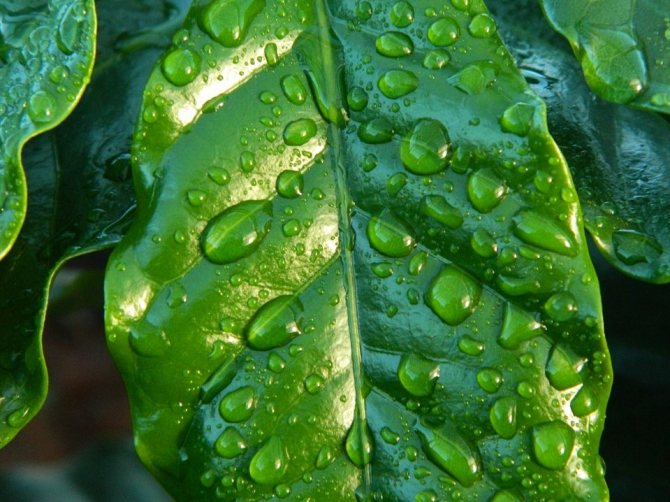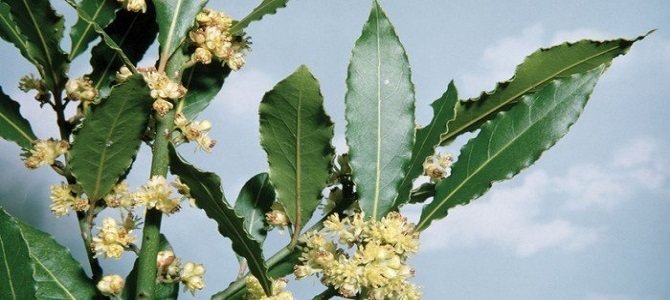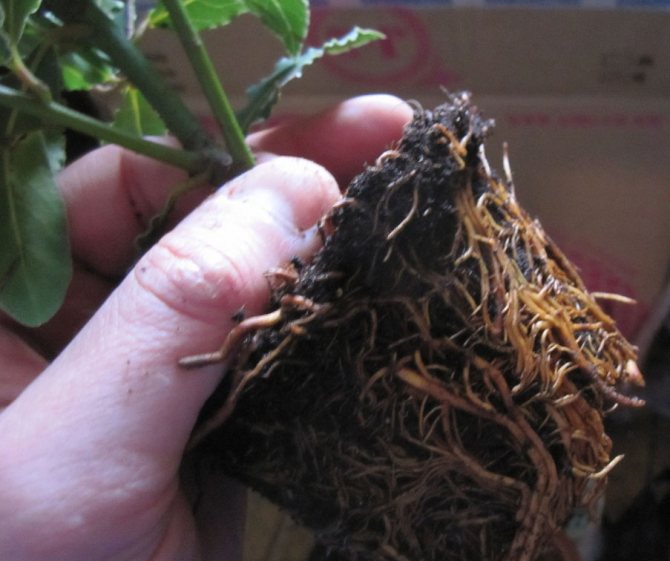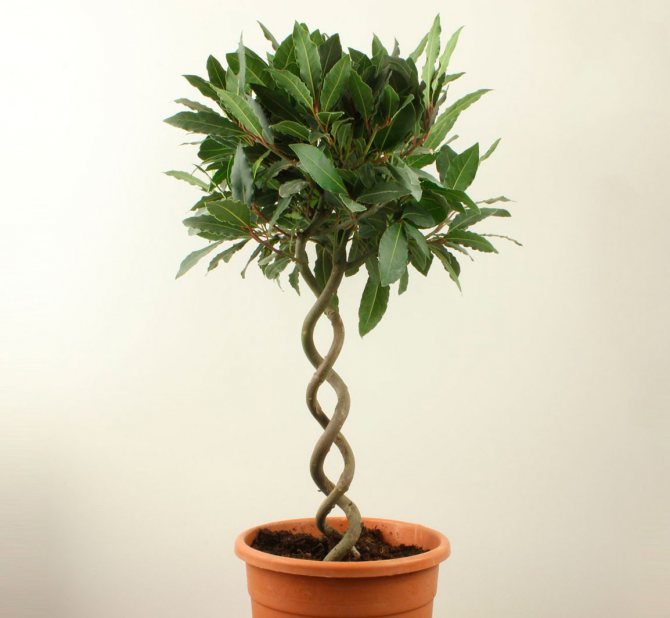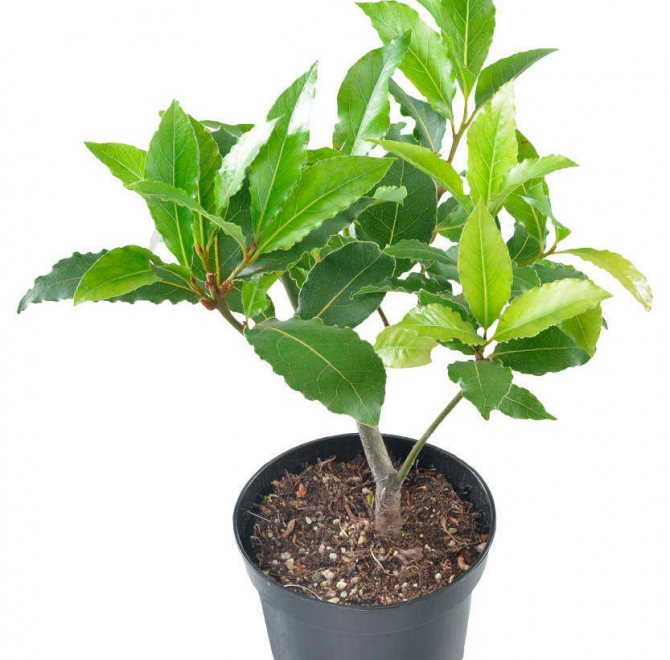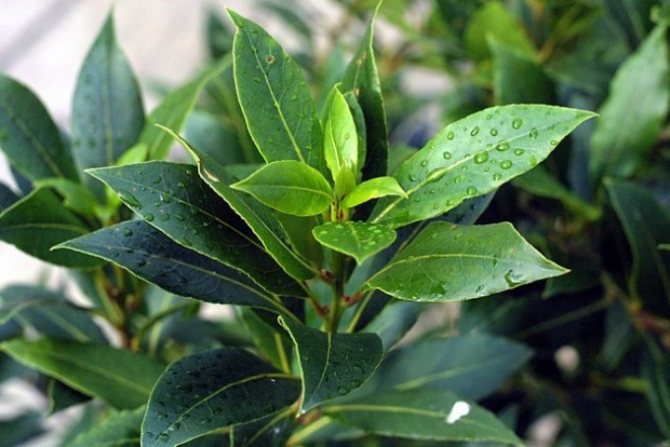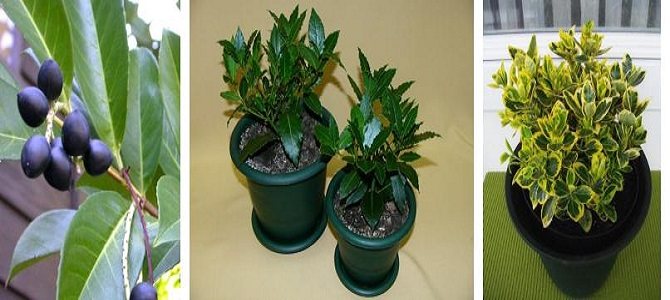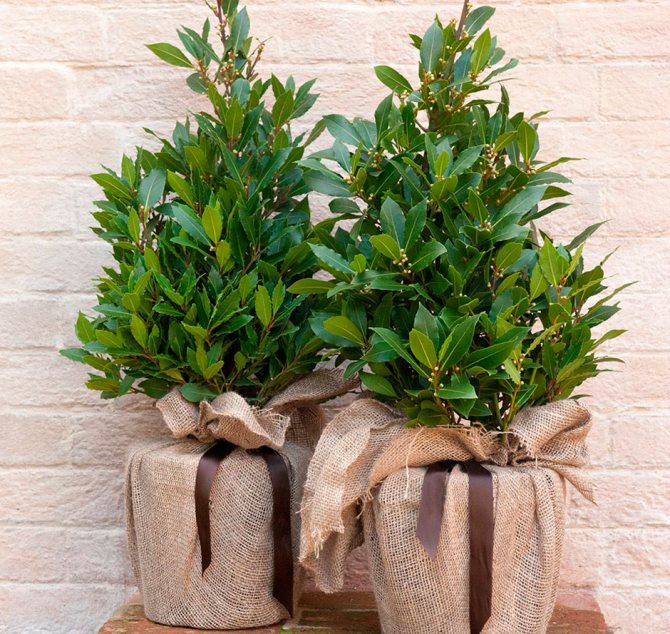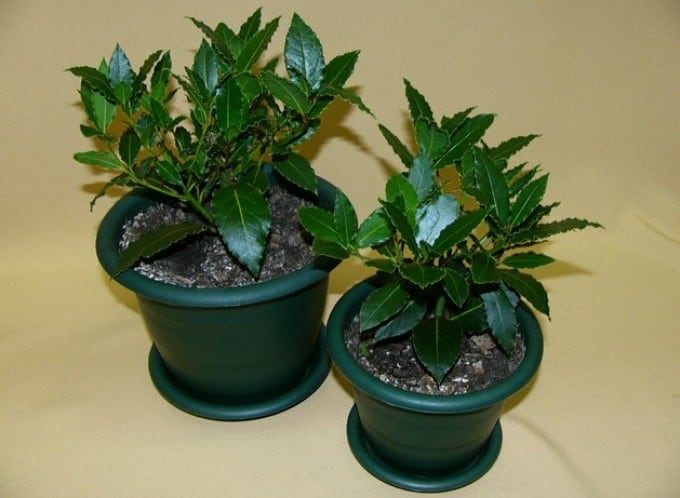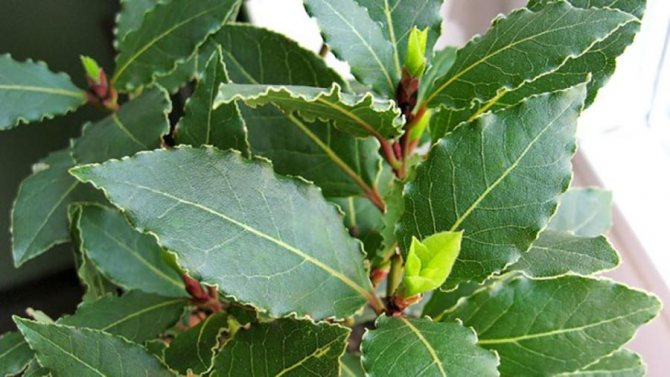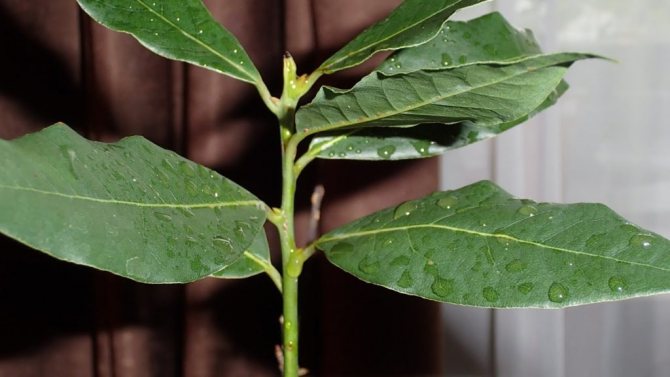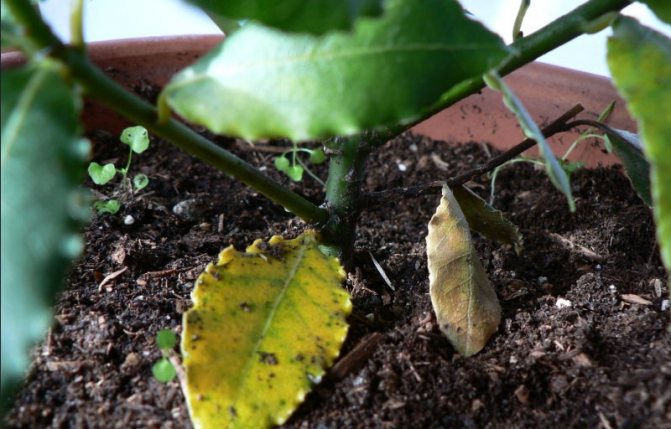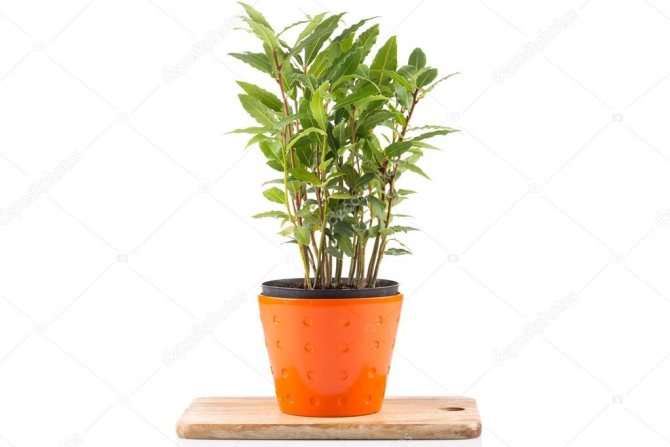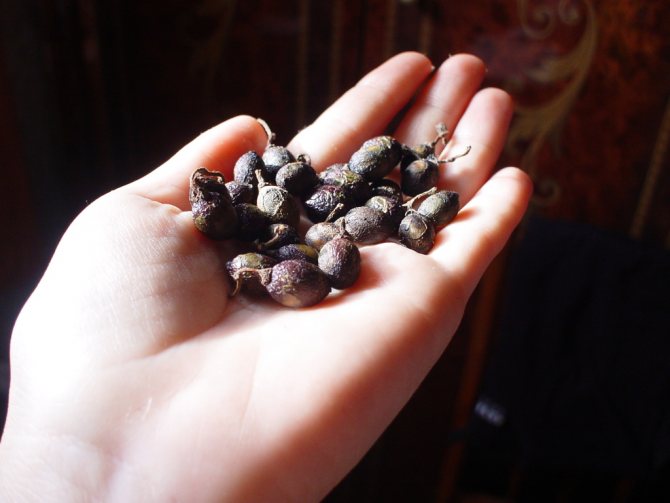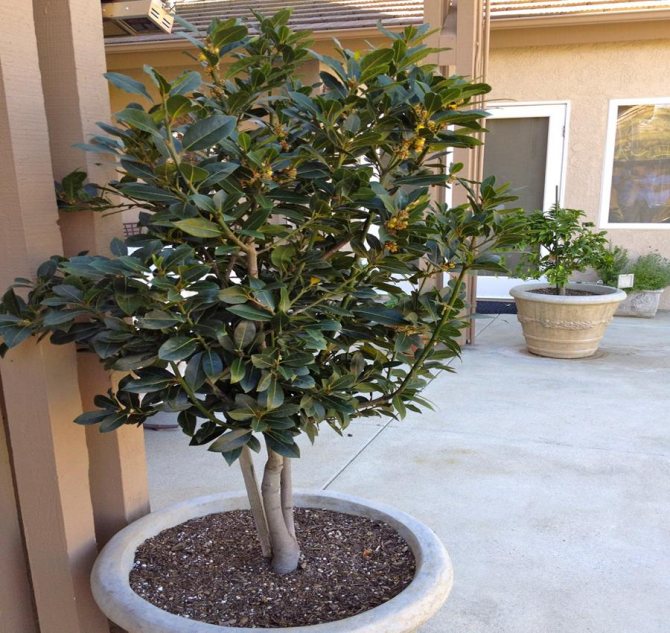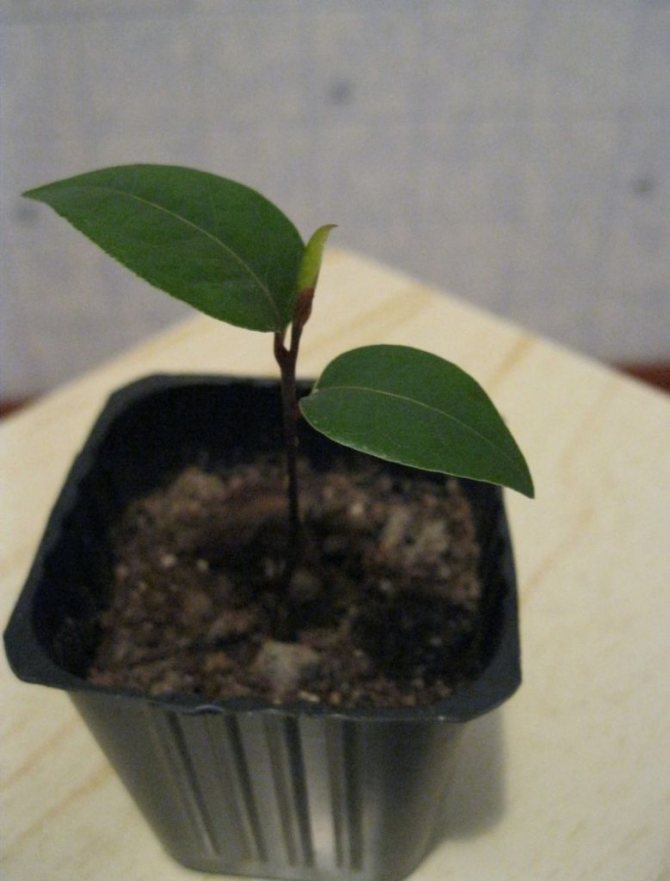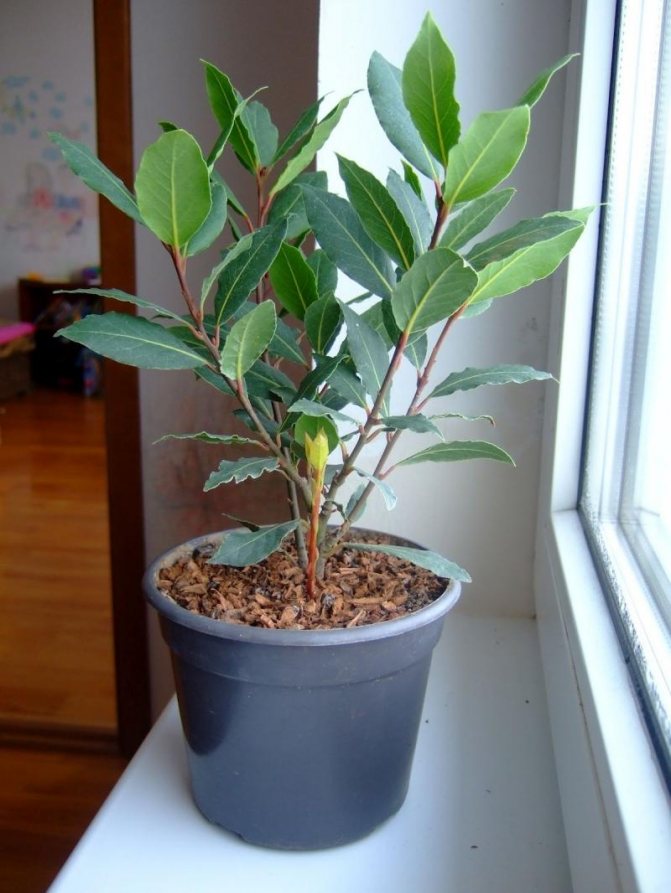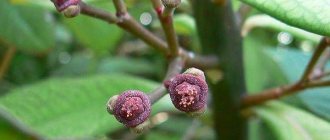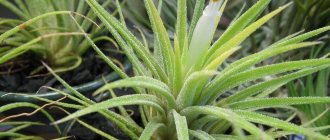The use of bay leaves in cooking has become a tradition; no hot dish can do without it. But not many people know that you can grow bay leaves at home. It will perfectly enliven the home interior and fit into the landscape design of the garden area.
Laurel noble adapts to any place of stay. Some tricks and rules for caring for a plant make it possible to grow a beautiful green shrub even in the open field.
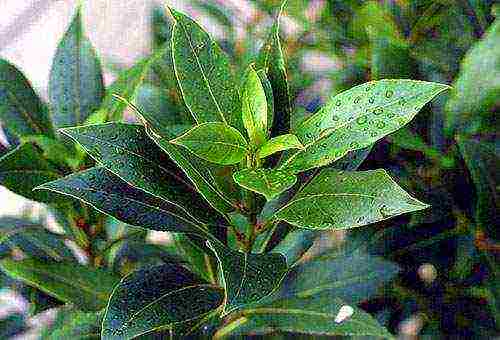
How to care for a plant at home
If you decide to grow laurel at home, you need to find a suitable place for it.
- You need to place the plant on a windowsill or on a flower stand, where there is a lot of light and sun. In the shade, the plant develops more slowly. Do not expose foliage to direct sunlight.
- Ventilate the room often to prevent discoloration and drying out of the leaf tips.
- Water as the soil dries. The tree requires good drainage so that the root system does not rot from excess moisture. A refreshing shower and spraying will help moisturize the crown and avoid pest infestation.
Advice
For watering, it is recommended to use an aqueous solution with baking soda. To prepare it, you will need 1 liter. running water and ½ teaspoon of soda.
- It is worth maintaining the average temperature in the room, not higher than 25 degrees; in the cold season, the laurel should arrange a winter period at home, when the temperature of the content is 10-14 degrees, and watering is reduced and carried out once every 2 weeks.
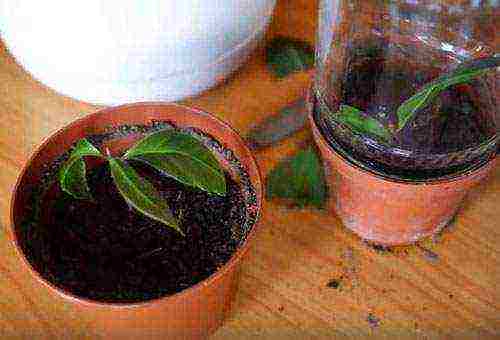

Recommendations for the care of laurel outdoors
Spraying and watering
Laurel easily tolerates drought. Although in the hot season it is advisable not to forget about watering and spraying. In the summer months, watering should be abundant, in spring and autumn at times - moderate. Limit soil saturation with water in winter - waterlogging negatively affects the condition of the plant.
Laurel is unpretentious in care. It requires:
- - abundant watering in summer - once a week;
- - moderate watering in winter - 1-2 times a month;
- - spraying with warm water, if young shoots of laurel are in a cold house or greenhouse (+3 .. + 5 degrees).
The key to growing laurel is an optimal watering schedule.
Fertilizing laurel tree
For proper soil fertilization, you need to adhere to the basic rules:
- - the land for planting should easily absorb water and allow air to pass through;
- - the ideal composition of the mixture: equal parts of soil, peat and sand;
- - fertilize the soil with organic and mineral substances in the spring and summer once every 2 weeks, in the fall and winter - once a month.
How to prune laurel
It is recommended to prune the laurel in winter. The operation on the stem is carried out at a level of 10 cm from the soil. Short stems are covered with soil. The plant has high regenerative properties. Laurel noble in the process of growing will quickly show new sprouting branches from dormant and root buds in the spring. In the middle climatic zone, do not let the laurel grow in height - grow the plant in small bushes.
How to preserve laurel in winter
During winter, watch your watering frequency if the winter is dry and without snow.Be sure to cover the bushes with straw up to 40 cm high before spring comes. You can add additional snow to feed the plant.
How to plant correctly?
The growth and development of the plant depends on the correct planting. Before starting, it is necessary to prepare all the components of the process: layering, pot, soil, mineral fertilizer, drainage, shovel.
- Take a small pot, because the plant develops slowly, and a large container will inhibit growth.
- Pour drainage on the bottom (2–3 cm). You can take expanded clay or ordinary foam, which must first be broken into small pieces.
- Prepare an earthen mixture: sand (1 part), peat soil (1 part), leafy soil (2 parts), turf soil (4 parts) - and fill the pot halfway.
- Place bay leaf in the middle, cover with mixture and tamp lightly.
- Water the plant with the diluted mineral complex.
The plant is transplanted at home into a new pot once every 2.5–3 years due to the slow development of the root system and the upper part.
An adult tree is replanted every 4 years or the top layer is renewed every 2 years. In the warm season, the plant can be placed outdoors.
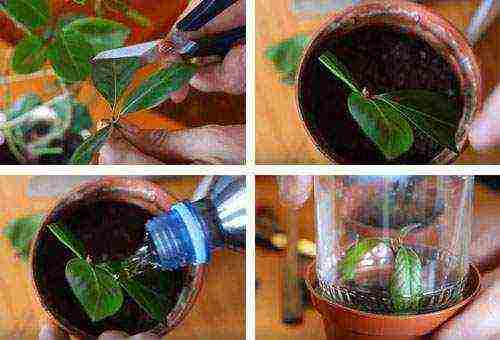

What conditions need to be provided for the comfortable growth of the plant
For growing outdoors, you need to focus on the south of our country. The laurel, ideally, is not immediately planted in open ground. Frost resistance of a plant with a range from -9 to -12 ° C. The branches and trunk are able to withstand sub-zero temperatures of 15 degrees without obvious damage. When planting laurel in the country, take care of the soil, moisture and light.
The plant accepts different types of soil well, however, excess moisture in it must be avoided. For a high essential oil content in the leaves, stop in a well-lit planting area. It is advisable to prune the laurel at the beginning of spring, until the leaves begin to grow actively. During the first year, the soil does not require additional feeding. In the second year of life, laurel bushes can be fertilized with a small amount of a mineral solution.
Reproduction methods
There are several ways to propagate a noble laurel at home:
- cuttings;
- planting seeds;
- separation of offspring.
Reproduction requires not only experience and skill, but also patience.
Cutting is one of the most time consuming methods, using a large, sturdy tree. To do this, you need to act according to the following algorithm.
- Separate the twigs with 4 internodes neatly with a utility knife or blade.
- Dip each of them in a substance for active growth of the root system (you can find it in any specialty store). Place in a container with water until roots form. Cuttings can be placed in moist perlite by covering the top with a glass jar. The plant must be periodically ventilated to prevent decay.
- After the roots appear, transplant into a ceramic or plastic pot.
Seed propagation is the longest process; seedlings may appear 60–65 days after planting.
Sowing should be carried out in early spring, as a soil, you can use a universal planting mixture. The seeds are placed at a depth of 1.5–2 cm, slightly moistened on top and covered with glass containers, which must be removed periodically to ventilate and moisten the soil.
Advice
Opt for fresh seeds that have been recently packed, because bay leaves tend to quickly lose germination quality.
Growing a leaf by separating the offspring is an easy and fast way to reproduce. When transplanting an adult plant, it is necessary to separate the “children” with roots from it and plant them in a separate small container.
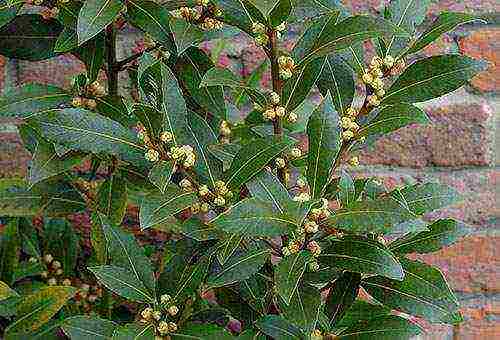

Laurel pests
My laurels never hurt. And at my friends they were attacked by scale insects and spider mites.Chemistry was not used, they fought with folk remedies. Month - another attentive treatment and plants again delight with their healthy appearance.
There is a simple rule to keep plants from getting infected and stay healthy. Flowers, branches and any plants brought from the street from the store as a bouquet should not be placed in the room with our home laurels. The same rule, only with even stricter observance, applies to homemade citrus fruits.
If pests have appeared on the plant, then we do not hesitate, but immediately get down to business. Since laurel lives in our home and we use the leaves for food, we will not use various insecticides. Multiple plants can be dealt with with home remedies as well.
We treat a home plant for scale insects with folk remedies
It is quite easy to suspect a scale insect. A sticky bloom appears on the leaves, and bumps resembling wax appear on the branches and petioles.
A soap-kerosene solution will work best with the shield. We take a container with lukewarm water and wash off a piece of laundry soap in it, you should get a concentrated soap solution. Coniferous soap can be used. Add to the resulting soap solution of 0.5 liters - 5 drops of kerosene.
We put the pot with the plant in the bath and cover the ground with plastic wrap, in order to avoid getting the product on the ground. The tubercles from the branches, leaves and their petioles are cleaned off, and then we process the whole plant with a cotton pad or cotton swab, not missing a single site to the ground. We often change the fleece. Insects that are poorly visible to the eye remain on them.
Let stand for 30 minutes and rinse thoroughly with a shower. It is necessary to completely wash off the soap and kerosene, you need to get rid of the pests, but not burn the plant. Carrying out treatments weekly for 1.5 - 2 months is guaranteed to relieve you of the scabbards. That's how I got rid of them on lemons.
Getting rid of spider mites
Another nuisance can be a spider mite. He also migrates to us from other plants. It's easier to prevent infection, but when pests get into our house, we gain patience and begin to treat our green friends.
Two compositions helped me well: soapy garlic and wormwood. For the first, prepare a concentrated soapy solution and crush 1 head of garlic in 0.5 liters of water with a garlic press. Let it brew for ½ hour and carefully process all the leaves, twigs and stem with the resulting composition.
We do not miss a single part of the plant, including the underside of the leaf. After half an hour, rinse the plant with a cool shower. We carry out processing every week 3-4 times. Usually, so many treatments are enough, and your plant will completely get rid of the spider mite.
The second effective remedy for the pest is a wormwood decoction. For 1 liter of water, take 80 grams of dried wormwood herb and insist for two days. Boil for 30 minutes, filter and process the plant with this infusion after cooling.
After half an hour, the plants are rinsed under a warm shower. Treatments are carried out every other week for a month. This is usually enough to get your plants completely healthy again. And yet I repeat: it is much easier to prevent infection of plants than to deal with their processing.
Proper maintenance in the garden
Average frost resistance allows you to grow shrubs in the open field or in a greenhouse. Bay leaves can freeze at temperatures below 13-15 degrees.
Advice
If, nevertheless, you took the risk of purchasing a plant in a region where the temperature in winter drops below this norm, plant it in a wooden tub or garden pot. This will transport the laurel to a warmer location.
Conditions that must be observed when growing in the garden:
- choose a sunny place for landing;
- neutralize the acidity of the soil;
- provide moderate watering;
- timely feed the plant.
This plant easily tolerates pruning, therefore it is a favorite shrub of experienced gardeners. In the southern regions, laurel hedges are common, which are given various interesting shapes and adjusted to the design concept.
Bay leaf is an unpretentious plant, it can be grown with pleasure at home, with little experience in floriculture.
By planting a shrub outdoors, you will get a versatile decorative element in your garden plot. Simple rules for planting and caring for a plant will allow you to grow an environmentally friendly seasoning for culinary masterpieces at home.


Bay trees are cultivated in subtropical latitudes, and they grow there with pleasure. In Russia, laurels can be found in nature in the southwest of the Krasnodar Territory. However, like many other thermophilic plants, laurel can be grown at home. You just need to carefully consider the needs of this Mediterranean miracle and take care of it in the same way we take care of fish, parrots and other pets. Bay trees are cultivated in subtropical latitudes, and they grow there with pleasure.
Bay leaf growing at home In Russia, laurels can be found in nature in the south-west of the Krasnodar Territory. However, like many other thermophilic plants, laurel can be grown at home. You just need to carefully consider the needs of this Mediterranean miracle and take care of it in the same way we take care of fish, parrots and other pets.
Information about the culture laurel
Laurel belongs to evergreen flora. This is a representative of the Laurel family, whose homeland is the Canary Islands and the Mediterranean countries. This plant has a rather long history of existence, but people have known it since ancient times - then the ancient Greek heroes-winners were laid on their heads with laurel wreaths.
In its natural habitat, this culture reaches an impressive height ranging from 10 to 18 meters. You should not be afraid of this, because home laurel is a more miniature exotic. Its maximum "growth" can be 1.5-2 m.
Laurel is represented in nature by two life forms: tree crops and shrubs. Both have simple leathery leaves with slightly wavy edges, in the axils of which the inflorescences of the "umbrella" type develop.
In total, the genus Laurus has about 40 species.
by modern standards. However, in indoor culture, the only variety of evergreens has become widespread: Laurel noble. This species can be seen in nature in areas overgrown with forests, as well as on the sea coasts and at 300 meters above sea level. Laurel noble has bare branches, short-petiolate oblong-lanceolate leaves with a glossy surface, umbellate inflorescences consisting of small flowers. This species blooms in late spring. Laurel noble in room culture is used for gardening at home and as an essential oil exotic. It is suitable for decorating halls. This species is also cultivated in the open field.
Laurel - houseplant


Laurel houseplant Fresh laurel leaves have a calm pleasant green color that will enliven any interior. Fragrant leaves will freshen and purify the air in your home, thanks to their ability to release phytoncides, which inhibit the development of bacteria and fungi. Laurel is a rather unpretentious plant. It is not as picky about growing conditions as lemon, for example. And if you plant a bay leaf at home, it will thrive even in the northern part of the house in less light conditions. But still, with sufficient illumination, the plant will turn out to be much lush and thicker.The full-fledged bay leaves that are used in cooking will appear on your personal bay tree within two years. It is at this age that the leaves acquire a rich aroma. In indoor conditions, laurel grows up to two meters, and with especially good care, even higher. So you can generously share your own bay leaf harvest with your friends. For laurel, propagation by seeds, layering, cuttings and seedlings is acceptable.
Laurel noble
Laurel: a description of a spicy plant


In nature, laurel can be both a tree and a very tall shrub, 9-11 m high.The thickness of its trunk can reach 40-45 cm.When growing laurel at home, it grows only up to 2 m.Its bark and shoots are smooth, mostly brown in color ...
Laurel leaves are solid, straight, naked, short-petiolized and whole-edged, up to 20 cm in length, and up to 5 cm in width. They are dark green above, and lighter below. They have a very pleasant spicy aroma. Laurel flowers are small, yellowish and unisexual, appear in inflorescences at the ends of branches, 6-12 staminate and 2-3 pistillate.
Did you know? If you grow laurel at home, it may not bloom at all, and if it blooms, then in late spring.
Under natural conditions, laurel grows for more than 100 years; when grown at home, the life span of a laurel tree can be up to 15 years.
Growing laurel from seeds
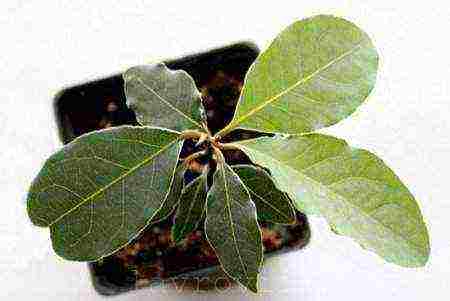

Cultivation of laurel from seeds The method of growing laurel with seeds is the most reliable, since the development of young plants from the very beginning occurs in the same conditions, and therefore they are not subjected to special stresses. Laurel seeds can be found in flower shops or ordered online. Great luck and almost one hundred percent guarantee - freshly harvested seeds. But in any case, before sowing, you need to store the seeds in the refrigerator. This is the key to their best germination. In addition, laurel seeds have a thick skin, and in order to facilitate the emergence of a sprout, the seeds are soaked for several days. To accelerate germination and stimulate growth, it can be soaked in a special activating solution. For example, the growth drug "Epin" has shown itself to be excellent. Any fertile soil is prepared for sowing seeds, but the top layer in a 2-3 cm thick container must be steamed or calcined sand. This is the best environment for the development of laurel seeds. Seed peas are planted to a depth of 1 cm and covered with foil to retain moisture in the soil. Seeds germinate for a long time, up to several months. If you have patience and treat this process with love, they will surely hatch. The optimal period for sowing seeds is during the winter months (January, February). Then, even if the seeds are late and lie in the ground for six whole months before germination, they will begin to develop in a favorable period both in temperature and in light. And when this happens, they remove the film from the greenhouse and wait for the formation of the first leaves. Small laurels with two leaves can already be transplanted into a separate pot. The site has detailed instructions for growing laurel from seeds.
Care and possible problems when growing laurel
The laurel tree does not cause any problems in the maintenance.... You just need to follow a few simple rules:
- Good lighting, but no direct sunlight on the leaves. South windows are best suited.
- The temperature in the autumn-winter time should be around +12. +15 ° C, in the spring-summer period - within +22. +25 ° C.
- In summer, watering is moderate, after the top layer of the substrate dries out (2-3 times a week). In winter, watering rewild (no more than 1 time in 7-10 days)... In hot weather, the plant is sprayed daily.
- Liquid mineral complex fertilizers are applied approximately once every 3-4 weeks (dosage according to instructions). Do not feed in winter.
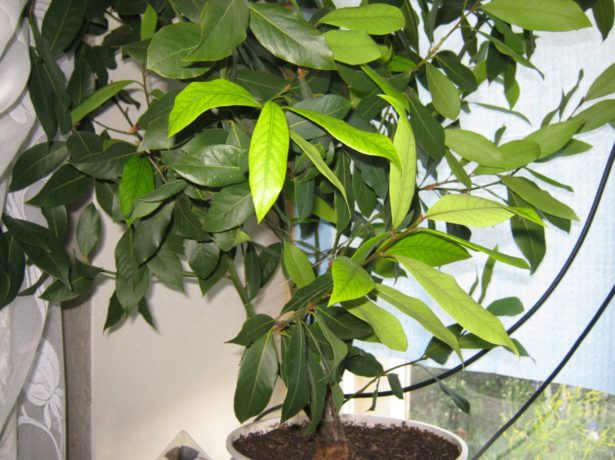

Laurel loves warmth and sun
Sometimes, due to mistakes in the care of a laurel tree, the following can happen:
- The foliage will turn yellow. The reasons are:
- waterlogging, which caused rotting of the root system, or poor drainage;
- bright sun rays, from which burns remained;
- cramped pot.
depletion of the substrate;
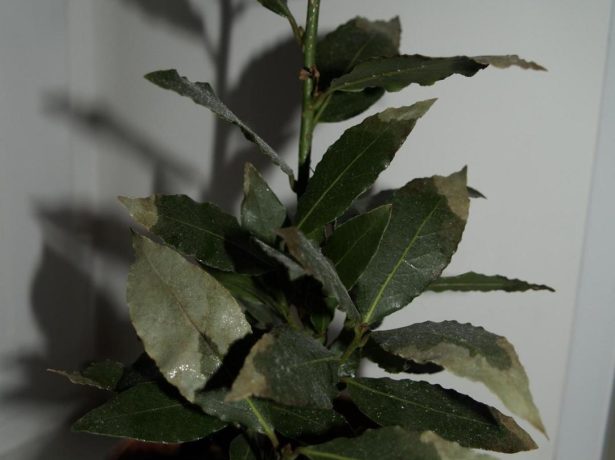

Laurel leaves can dry for various reasons.
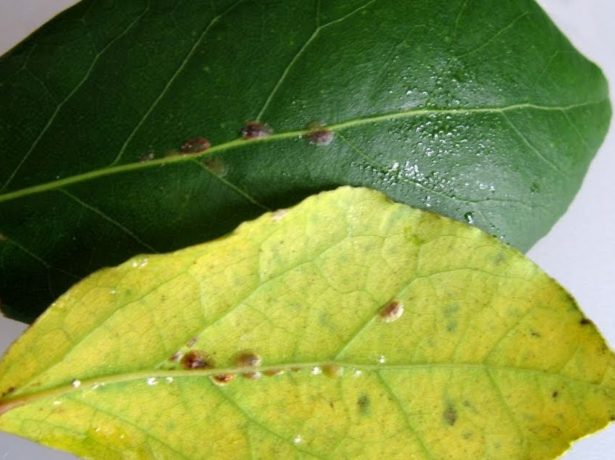

It is difficult to fight with scabbards, but you can
Once I brought home a new plant and did not notice a scale insect on its leaves, apparently, the insects were still very small. But then they grew, bred and crawled over to neighboring flowers. I fought with them for a long time, because no chemicals penetrated through the hard shield shell. I had to collect everyone by hand, and only then spray the plants and soil in pots with insecticidal solutions.
How to propagate bay leaves at home
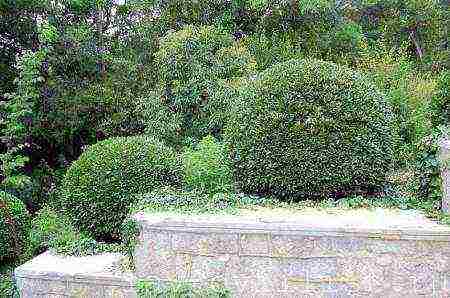

How to propagate bay leaves at home
Growing laurel from cuttings


Growing laurel from cuttings Growing a plant from cuttings is a more laborious process than sowing seeds. Laurel cuttings are harvested from an adult plant in the spring, when the trees wake up after winter, or in the first half of summer. Very successful cuttings are obtained from annual shoots that have not had time to lignify. The branches are cut into 6-8cm pieces. Each cutting should have three internodes, that is, three free areas between the places of attachment of the leaves. For grafting, it is better to use the lower or middle part of the branch. Each stalk should have an oblique cut below. Then the first leaves must be removed, and the top ones must be cut off, leaving half a leaf - in order to minimize moisture evaporation.


Pruning bay leaves Any soil is suitable for bay leaves, but for planting cuttings it is better to prepare a nutritious substrate of your choice: a mixture of 1 part of leafy soil with 1 part of marsh moss; a mixture of 1 part of sod land and 1 part of sand; a mixture of 1 part sand and 1 part moss; just coarse sand.
Bay plants are very tolerant of any soil. The only thing they cannot stand is excessive waterlogging. So, almost the main condition for the successful cultivation of laurel is good drainage.
It is advisable to steam the prepared soil in order to avoid damage to the cuttings by pathogenic bacteria. The sand can be ignited. Any suitable drainage is placed at the bottom of the container.
For better rooting, you can use special stimulants that promote root formation. Powder Kornevin is suitable for this purpose. The lower part of the cutting should be dipped in the growth preparation powder. And you can withstand the bases of the cuttings (immersed by 2-3 cm) for a day in a special solution of heteroauxin. The roots from such a procedure will turn out to be well branched and strong. Some gardeners use phytohormones for better rooting, and also organize bottom heating for cuttings.
The cuttings are buried 1.5 cm in the ground. They need to be provided with watering and a temperature of at least 22 degrees. To maintain the temperature regime, the cuttings are covered with a suitable transparent material: film, glass or a jar. Every day, the shelter needs to be briefly removed or opened for ventilation. It is useful not only to water the cuttings, but also to spray them with water. The first three weeks - this should be done 4-5 times a day. Then the number of sprays is gradually reduced. It will take about one month for rooting. Once the plants have taken root, you can transplant them into another container. For the substrate, garden or sod land, leaf land and sand are taken. You can add a little peat and lime (5-10g).
Growing seedlings from horizontal layers


Growing seedlings from horizontal layers A laurel tree can be grown from a layer, as is done with grapes. Take one of the lower branches, put it in a groove, pin it to the ground and sprinkle it with soil.In the place where the branch will cover the ground, you need to make an incision or at least a scratch on the bark. A prerequisite for successful germination is a sufficient amount of moisture. As soon as a green sprout appears from under the ground, you can dig out a layer and cut it off from the main branch. Then plant the young plant in a separate container.
Growing laurel seedlings


Growing laurel seedlings Buying ready-made laurel seedlings is no longer a problem. And the price for them is very democratic. As soon as pets appear in the house, they need to be placed where there is diffused lighting or partial shade. At least they don't need direct sunlight for the acclimatization period. It should also be the coolest place in the house, since laurel is not one of those who love high temperatures. A pleasant thermal regime for laurel is 15-20 degrees in summer and 10-12 in winter. Laurel loves humid air. Therefore, humidification can be arranged in different ways: by spraying, containers with water next to the pot, shower. When the time comes to pinch and prune bay trees, move them to a lighter spot for better branching.
Where to place the laurel and how much light does it need?
The location of the plant in the room is also important. It should be noted that the plant is not picky about the level of lighting, but it really does not like places where it often comes through. Unwanted gusts of cold wind will significantly slow down growth, but you need to ventilate the room where the laurel grows regularly.
If the owner of a residential building or apartment wants to achieve flowering, which happens in rare cases, it is necessary to bring the growing conditions as close to natural as possible. For example, you will need to place the laurel in a place where it will be constantly well lit. A large amount of daily solar radiation has a positive effect and gives the laurel an excellent appearance. In this case, each leaf on the tree will become a decorative element and will delight the eyes of others. The bush will become dense, and this is very difficult to achieve in places where shade prevails most of the time of the day.
Recommendations for proper cultivation
Recommendations for the correct cultivation of laurel Laurel responds well to organic fertilizers. This could be, for example, pigeon droppings. It is diluted with water, preferably settled. For one part of the litter, take 20 parts of water. Laurel will also accept mineral fertilizers well. You can feed him once every three weeks.


Recommendations for the correct cultivation of bay leaves Laurel is very fond of water, so at least once a month he needs to arrange a warm refreshing shower. You also need to water the plant with warm, settled water. In the cold season, this is done once every five days, and in the warm season, more often - once every three days.
Bay trees need to be repotted periodically. At a young age, the transplant is carried out after two years, and older trees need to be disturbed less often - once every five years. After transplanting, laurel does not need to be fertilized for about six months. But fresh air will not interfere with it. As long as the temperatures allow, the laurel can be kept on the balcony or in the garden, and brought into the room before winter.
Growing a bay leaf at home will require knowledge of its needs and growing conditions - all of which you will find in this guide. It is one of the most commonly used and well-known spices, and you can get fresh leaves any time of the year if you plant this plant. Learn all about how to grow a bay leaf in a pot on a windowsill and see for yourself all its benefits.
Why is it worth growing a bay leaf?
Gourmet spice
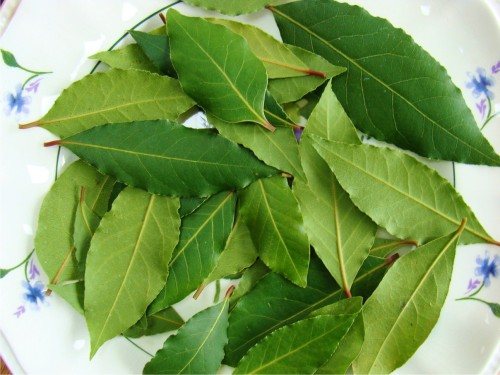

Perhaps no other seasoning is used as often as bay leaf. Fresh and dry laurel leaves are suitable as a spice. Its seeds are sometimes used. Bay leaves can enhance the taste of almost any product.It is used to prepare meat and fish dishes. In addition, it is added to marinades, sauces, broths and soups. In particular, it is used for the preservation of cucumbers, zucchini, tomatoes, cabbage, squash and other vegetables. Best of all, laurel goes well with beets, tomatoes, cucumbers and cabbage. An essential oil is obtained from bay leaves, which can be used in the production of confectionery and alcoholic beverages.
It is recommended to add laurel to dishes already before the end of cooking. Otherwise, it can begin to give bitterness, which will only ruin the dish. It is good to put a lot of bay leaves in a dish, but for a short time, and then remove them from there. In this case, they will give only the best notes of their scent.
About the benefits of the plant
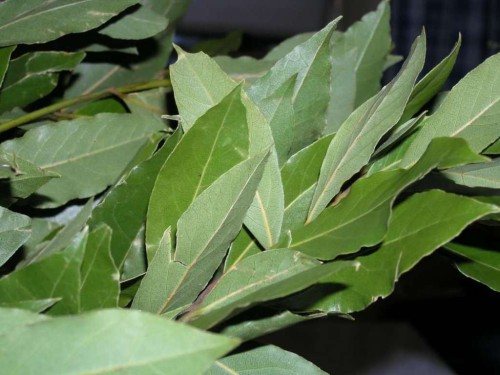

Even in ancient times, bay leaves were used to treat various diseases. In particular, it is believed to help relieve pain during childbirth, and the oil derived from the plant can help with cramps. In addition, ancient healers used laurel for nervous tension, joint pain, to relieve shortness of breath. The seeds and bark of the tree were used to prepare a decoction for urolithiasis and cholecystitis.
Today bay leaves are used to improve digestion, appetite, to lower blood pressure, relieve edema, to suppress the development of tuberculosis, diabetes and rheumatoid arthritis. Laurel is considered a good natural antibiotic. It is also used to improve metabolic processes. Thanks to tannins, it allows you to relieve swelling and inflammation. If you properly prepare a decoction of bay leaves, then with regular use it will become an excellent tool for strengthening immunity and restoring the body after a long illness.
Laurel is also known to have good diuretic and astringent properties. It is used as an antifungal and antibacterial agent. In addition, it can help with stomatitis, fever, nervous system disorders, and amenorrhea. It is also an effective emetic and diaphoretic. It is used in folk medicine to treat sprains, bruises and joint pain.
The essential oil of the leaves, flowers and fruits of the tree is used as an insecticidal and disinfectant. It is also used to prepare medicinal soaps and ointments. A decoction of bay leaves is necessary to accelerate the elimination of excess salts from the body. In addition, it allows you to get rid of salts in the joints, gallstones. The same broth is useful for diabetes mellitus. Just don't take it every day. It is quite enough to conduct a three-week course in a year.
How to choose a bay leaf
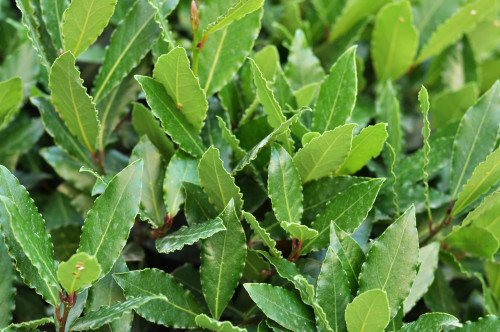

Laurel retains its beneficial properties well even when dry. Therefore, there is no point in looking for fresh leaves somewhere. Dry leaves contain almost the same amount of essential oils. They also retain their anti-cancer and antibacterial properties. Thus, both raw and dried bay leaves can be consumed. You just need to be able to choose it correctly. In particular, you need to pay attention to the outside of the leaflet. There should be no stains on it. Leaves, as we said, are harvested from November to February. Therefore, it is better to buy laurel during this period.
Bay leaf storage rules
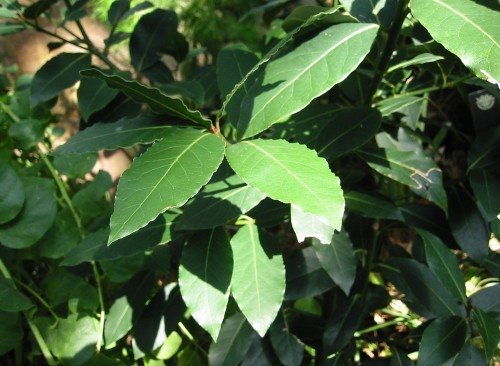

Protect bay leaves from moisture. Any sealed packaging is suitable for this. For example, you can take a glass jar and close the lid tightly. Sometimes laurel is already sold in sealed packaging, into which air does not penetrate. This is the so-called reusable zip fastener. Despite the fact that the bay leaf persists for a long time. You should not store it longer than it suggests its expiration date, which must be indicated on the packaging. If the bay leaf "stays over", then it can start to taste very bitter.
General information
Laurel leaves give off an intense aroma that complements most Mediterranean dishes.
Bay leaves have a variety of uses, from decorative to culinary and medicinal.
Although this plant is an evergreen shrub or tree in its native Mediterranean, its growth is easily contained by pruning or container planting.
Laurel grows very slowly, which makes it even more suitable for potting at home.


Propagated by seeds and cuttings (twigs).
How and when to harvest laurel
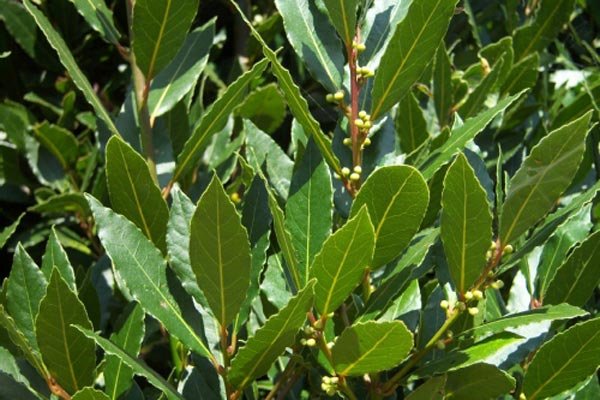

The laurel tree is a beautiful ornamental plant, and one does not want to spoil its beauty, because a bag of lavrushka costs a penny, and no soup is worth such sacrifices. If you have grown a laurel tree for using the leaves for food, then know that the leaves for consumption can be stored when the laurel tree is 3 years old. Leaves at this time are just the most suitable. A four and five year old plant will not work.
Cut the leaves with young shoots and dry them in twigs in the shade. After drying, pluck the leaves from the branches and pack them into containers to keep them dry. Harvested only in dry weather.
Soil and pot
Laurel has no special requirements for the soil: it grows in any, with the exception of heavy and clayey, which causes waterlogging. Like many other plants, it prefers well-drained soil.
Drainage is very important, so choose a pot with large drain holes.
Start growing a bay leaf in a small pot and transplant it into a larger container when you see roots coming out of the pot's drainage holes. Take your time to plant this plant in a large container at once. A laurel tree thrives when it gets a little cramped.


How to plant laurel?


The cultivation of this plant begins with planting. This procedure is carried out in the spring. The first step is to create a special drainage layer at the bottom of the pot used and only then fill it with previously prepared soil. Here, it is possible to use ordinary flower soil, which is sold in many stores already ready-made. Certain gardeners prefer not to buy soil, but to make it themselves. Here you need one part of leafy soil, one part of turf, one part of humus layer and two parts of ordinary white sand. These components are thoroughly mixed until a homogeneous mass is obtained.
Types and varieties
If you plan to use bay leaves for cooking, it is very important that you grow a plant called Laurus nobilis. Other species of this plant, also called laurel, are not all edible.
There are several decorative varieties of laurel:
- Angustifolia is a narrow green leaf.
- Aurea - yellow foliage.
- Sweet Bay, also called Bay Laurel, is a bright green coloration.
- Undulata - The edges of the leaves are wavy.
Varieties of laurel
The Lavrov family has three main varieties:
- Laurel noble. It grows in Western Transcaucasia at an altitude of 300 m above sea level. It occurs in the form of a tree and shrub, reaches a height of 4-8 m. It blooms with small yellow flowers. The most popular varieties are narrow-leaved, golden and wrinkled.
- Laurel camphor. This variety grows in Southwest Asia, the USA, Australia, Africa, Brazil. A distinctive feature is light dots on the leaves. Flowers are yellowish-green, combined in paniculate inflorescences. All organs of the plant contain camphor essential oil, which is used in the production of medicines.
- Laurel Azores (Canary). Grows in the Canary and Azores Islands, on the island of Madeira. The tree will grow tall up to 15 m. The leaves are oblong, 10-12 cm long.Small pale yellow flowers open in the axils of the leaves.
How to grow bay leaves from seeds
Laurel seeds are very difficult and slow to germinate, so many people prefer to purchase a ready-made plant in a pot. If you want to grow bay leaves from seeds, here's what you need to do:
- Fill a small flat container with moist, loose soil.
- Sow the seeds and cover with a 1 to 2 cm layer of earth.
- Cover the container with plastic wrap, leaving an air hole on the side.
- The required temperature for germination is 20 C. Be prepared to wait 5-12 months before the seeds hatch.
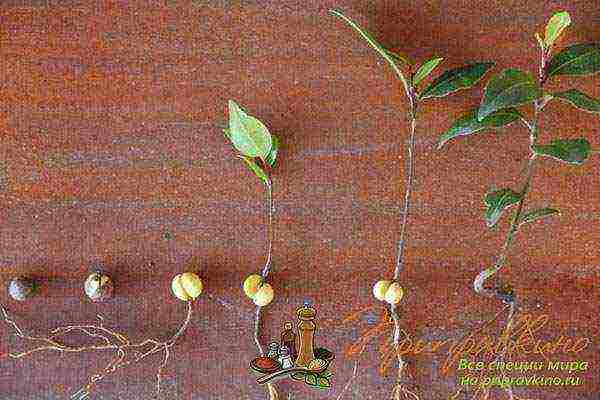

This is the most difficult method, as germination takes a long time and attempts to grow laurel trees from seeds sometimes fail.
Planting and caring for laurel in the garden
One of the most popular plants is
laurel (Laurus nobilis)... Its leaves are widely used in the culinary field as a spice. Laurel is native to Mediterranean countries. The ancient Greeks brought the plant to the Black Sea coast, and after that they began to plant it on open ground in the warm region of the country. In nature, there is also a wild plant in the form of a tall tree 10-12 m high. In colder climates, laurel grows in the garden in the form of bushes.
Laurel – it is a dioecious plant with unisexual flowers.
Some types of laurel trees have small inflorescences with stamen flowers.
Fruit – fragrant black-blue drupes up to 2 cm long with a large stone.
Laurel usually blooms in March-April, and the fruits ripen in mid-autumn.
How to grow bay leaves from cuttings (twigs)
Ideal if you can get twigs of at least 15 cm from a healthy adult plant and plant them. The cuttings should be slightly firm, pliable, and green. This material is well suited for growing new bay leaves at home.
The more cuttings you take, the better your chances of successfully rooting a new plant.
Step-by-step instruction:
- Mix equal parts earth, sand and vermiculite and fill a small container with this mixture.
- Remove the leaves from the cuttings except for the top two. Cut the top leaves in half horizontally.
- Dip the bay sprig in the liquid root growth stimulant and keep it there for the required amount of time according to the directions on the package.
- Stick the bottom of the laurel stalk into the potting mix to a depth of 5 to 6 cm.
- Compact the soil around the cuttings and spray with water to help the soil settle down by the stems.
- Cover the container with a clear plastic bag to create a moist rooting environment for cuttings.
- Place the cuttings in a warm, well-lit area, but not in direct sunlight. The air temperature should be up to 22 C.
- Monitor plantings daily, throw away rotten or withered cuttings. Water when the soil layer is 1-2 cm dry.
- Check the roots once a month to see if they are growing. Gently pull the twigs upward to feel if there is resistance.
- Once the roots are 2 to 3 cm, transplant the new plants into separate pots.
Propagation of laurel by cuttings can take several months. This time is necessary for the development of a normal root system suitable for planting. However, sometimes the twigs never take root.


If you are not a fan of problems and experiments, then it is best to just buy a small laurel tree from a garden store. This way, you can enjoy it without frustration and effort.
Useful properties of laurel
Laurel is actively used not only to create culinary masterpieces, but also as a medicinal plant. Already only having a laurel tree in a tub at home can you help your respiratory organs. The aroma emitted by the tree cleans the air from toxic and harmful impurities.Also, laurel helps with diseases such as diabetes mellitus, arthritis, gout, rheumatism and spastic pain.
The aroma of laurel, when inhaled, relieves the painful condition of the intestines, various respiratory diseases. To benefit from growing laurel, you need to water it twice a week with water and aspirin. To do this, take 5 g of aspirin for 1 liter of water. This composition improves the aroma of laurel, makes it richer.
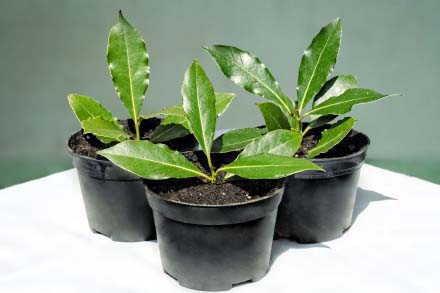

How to care
To keep fresh seasoning available at any time of the year, there are several guidelines on how to care for a laurel tree at home.
Watering
Bay leaves are drought tolerant but appreciates regular watering. Always allow the soil to dry out between waterings to keep the roots from rotting, but do not let the plant sit out of water for too long.
Laurel responds well to a shower at room temperature. At the same time, cover the pot with soil with a plastic bag.


Lighting
Laurel prefers a bright location, but it can grow in shade. Not afraid of drafts.
In spring and summer, sun protection is required on the windowsills of the southern sides.
Fertilizer
The bay tree needs to be fed with universal fertilizer twice a year: in spring and summer. A liquid fertilizer for cacti or palms works well.
Diseases and pests
Bay leaves are rarely susceptible to disease and insects. In fact, it is itself often used to control pests of other plants.
- Laurel can be damaged by scale insects, worms, on the secretions of which a sooty fungus settles. Clearly visible accumulations of worms are removed with cotton swabs dipped in soapy water.
- If laurel leaves turn yellow and fall off, it may be caused by excessive or insufficient watering of the plants.
- Leaf spots are often caused by boggy roots and excess moisture.
- Yellowed leaves can also be caused by nutrient deficiencies in the soil. To fix this problem, transplant your plant into fresh, well-drained soil.
Transfer
The bay tree does not grow very quickly in pots, so replant it no more than two to three years later.
Repotting is best done in the spring. Use fertile soil and good drainage as the plant does not like stagnant water.
Pruning
Pruning is an important part of caring for a laurel tree to contain large growth and give it a decorative shape.
It is usually carried out in the spring when new shoots start to grow.


Remove dried, damaged or diseased leaves regularly if they appear.
Diseases of the laurel tree
The laurel plant suffers from waterlogging, often brown or black spots begin to appear on the leaves. In this case, it is required to reduce watering and transplant the tree to another land.
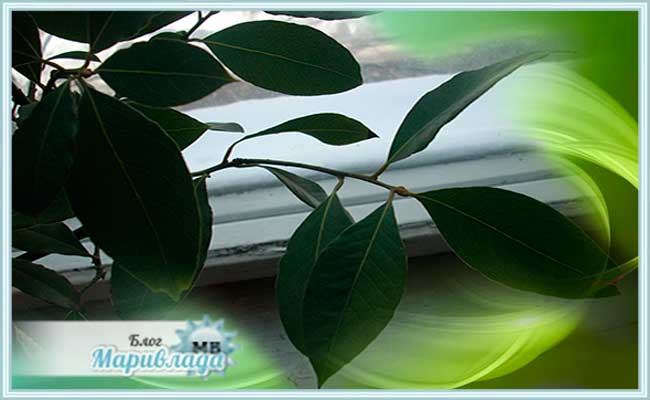

During the time when new twigs grow and the foliage is still young, the tips of the leaves can dry out in the heat. In this case, the plant should be shaded. Start spraying daily, even better. The main thing is not to spray in bright sun. In order not to cause burns.
Harvesting
If you have grown your plant yourself, from cuttings or seeds, then start harvesting from the second or third year of its life.
For seasoning, harvest the largest leaves: the older the leaf, the stronger the flavor.
The harvested leaves need to be dried, as fresh bay leaves are quite bitter. From the moment of cutting, 48 to 72 hours should pass. Of course, the store sells bay leaves that have dried much longer, but freshly dried leaves have a more pleasant aroma.
There are many reasons to plant a laurel tree on your windowsill. These are attractive, shiny foliage that stays green all year round at home. It is a delight with a sweet aroma with a spicy nutmeg flavor.Be sure to get involved in growing bay leaves and become the owner of an evergreen, glossy decoration for your home, the leaves of which are used in many recipes.
One of the most popular home-grown evergreens is the laurel flower. He may be a small bush or a miniature tree.
In ancient times, laurel wreaths were worn on the heads of winners and famous people. This plant is very convenient to grow at home, because, in addition to decorative decoration of the apartment, it also has useful functions. There is no need to run to the store for a bay leaf, you just need to pluck it from the tree.
Culture characteristics
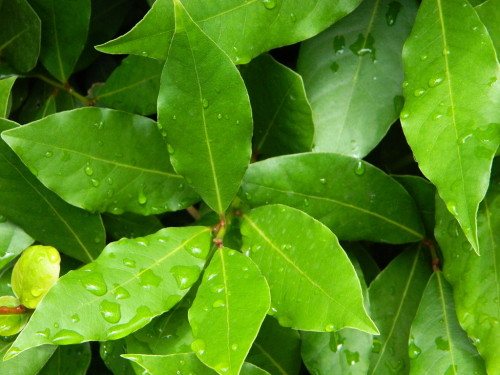

Today laurel is grown in Greece, Turkey, France, Italy, Spain, the Caucasus, Portugal, Guatemala and Albania. Bay leaves are used not only for culinary but also for medicinal purposes. In addition, it is used in the chemical industry as a raw material for the production of camphor and cineole.
A laurel tree usually grows only in sunny areas, but when it is freezing and in the shade, it feels bad. Bay leaves are harvested in autumn and winter, starting in November and ending in February. At the same time, the leaves of only those trees that are 3-4 years old and more are suitable for collection. And this is done along with the branches. In this form, they are dried, then separated and placed in special bags. Dried bay leaves can be stored for several years. Only in this case they should be in a dry room.


Bay leaves are known for their specific scent, which they have thanks to the unique essential oils they contain. They contain concentrated nylon, valerian, acetic acid. In addition, essential oils contain quite a few phytoncides that have antibacterial properties, as well as fatty acids, tannins and trace elements.
Characteristics
Laurel is an easy-to-care indoor plant. Even a beginner in flower cultivation can do this. In nature the laurel tree grows very tall... There are specimens exceeding 18 meters. Today, in the Sochi forests, you can see a laurel reaching 15 meters in height.
Although this plant is not very pretentious, it requires a favorable environment for it to grow well. This houseplant is very fond of the sun's rays, but it can grow well in a shaded place.
Laurel does not react to drafts, it is not afraid of drought. A laurel tree at home does not require much maintenance, it is necessary that there is always enough water, without waterlogging the soil.
Home laurel copes well with diseases, is not afraid of pests. To give a certain shape, laurel bushes can be trimmed. FROMmodern gardeners manage to grow tall laurel trees, differing from their counterparts in an openwork, intricately intertwined trunk.
Types of indoor laurel
This plant is subdivided into two groups:
- Noble;
- Canary.
Canarian laurel has wide, large leaves, the edges of which look somewhat wrinkled. This species loses to the noble laurel in terms of the strength of its aroma.
The main botanical variety of laurel is divided into three types:
- Narrow-leaved;
- Golden;
- Wrinkly.
Each variety is characterized by the shape of the leaf and its color.
How laurel is planted
The noble laurel should be planted in early spring. If you have already grown laurel earlier, then you need to pick up a pot whose diameter is a couple of centimeters larger than the previous one.
First, a drainage layer is placed in the pot. For this, you can use expanded clay or broken brick. The substrate is placed on this layer. For laurel, the soil should consist of sand, turf and leafy soil.... Such a composition is sold in the store, as land intended for breeding cacti.
Home laurel care
This houseplant is not very moody.But, it needs to be constantly sprayed and trimmed so that the crown has a decorative shape. It is also necessary to monitor the appearance of pests or diseases in order to prevent their development.
For good growth, the laurel does not interfere with a lot of sunlight at all. It can grow well in partial shade. In summer, when the temperature is more than 25 degrees, the bay bush can be left on the balcony... With proper care, indoor laurel can live for over 15 years.
In order to get a good growth of an indoor noble laurel, it is necessary to create conditions for him that resemble his native places. With the onset of cold weather, the optimal temperature in which a room laurel can safely be is 18 degrees.
Professionals recommend in January to lower the temperature to 10 degrees. In apartments where central heating works in winter, it is better to install laurel bushes away from heating radiators.
Where should the laurel bushes be in the apartment?
In order to grow a good laurel flower, it is very important to find the right location for it. It is desirable that the plant does not fall into drafts, the laurel does not like them. But you need to air the room with laurel regularly.
It is not required to create special lighting for the laurel. Normal room light is enough. To achieve the flowering of laurel at home, you need to take care of it, trying to bring the conditions of its location closer to real ones.
For example, a pot with a tree should be placed where there is a lot of light. So, with a large amount of scattered sunlight, laurel leaves will take on a more decorative look. The bush will be very dense, which rarely happens if the bay tree grows in more shaded areas.
How to water laurel bushes
In the spring and summer, the bushes need to be watered regularly. When it is very hot outside, watering should be more vigorous. But, prolonged waterlogging should not be allowed, because stagnant water in the soil can lead to rotting of the roots and death of the plant.
The watering schedule in the winter is very different from the summer. The substrate needs to be watered only after the top layer of soil in the pot begins to dry... Watering should be done with well-settled water at room temperature.
With the onset of heat, the noble laurel should be sprayed in the morning and evening hours. You can also place a container of water near a bay pot.
Experienced florists use another method. Pebbles are poured into the pallet, then it is filled with water, a pot of laurel is placed on top.
How laurel reproduces
Usually propagation of this unpretentious plant is carried out by cuttings, but you can propagate laurel and seeds.
To grow laurel from seeds, you need to have special soil. To obtain rapid growth, it is recommended to pre-soak the seeds in heated water and hold for a couple of hours.
The seeds do not need to be buried deep in the soil. It is enough to sprinkle them with earth and cover with foil.
When laurel propagates by cuttings, they must be cut off from shoots that did not have time to completely lignify.
With the onset of spring, the cut off shoots are planted in slightly moistened soil. It is advisable to remove all leaves from the trunk, leaving two or three. The length of the handle should not exceed 8 cm... For the plant to take root faster, it is worth using wet sand. Usually young seedlings take root well within one month.
How is the transplant done
This operation does not need to be performed very often. A small tree should not be transplanted into a large pot. Laurel will do great in a small pot.
When he grows up and the pot becomes cramped for him, another container is taken, with a large diameter of about 4 cm.
The transplant is performed by rearranging the earthen coma. The missing soil is poured into the pot. Then the transplanted laurel is watered well. Transfer work usually performed in the spring or summer.
How to transplant laurel?
Initially, it should be noted that the shrub does not need to be repotted frequently. This event is carried out as needed, namely, when the tree in this or that pot is already very cramped and there is nowhere to put the root system. It should be borne in mind that it is not worth replanting a plant in a large pot, it is enough to increase the volume by just a couple of centimeters in diameter.
The best transplant method is the transfer method. This procedure will minimize the risk of damage to the root system of the plant when transferred from one pot to another. The transplant is carried out in the spring, as well as at the beginning of the summer. It is at this time that the tree tolerates these activities better.
Sowing with seeds
How to grow laurel at home? For this, sowing with seeds can be selected. It will be possible to grow a laurel tree at home due to the observance of some rules. It is desirable that the seeds are southern, because then you get a high-quality laurel. Sowing is carried out in mid-February - early March. The seeds must be planted 1 cm deep into the soil. The temperature should be 20 ° C. The first shoots will appear after 3-4 months.
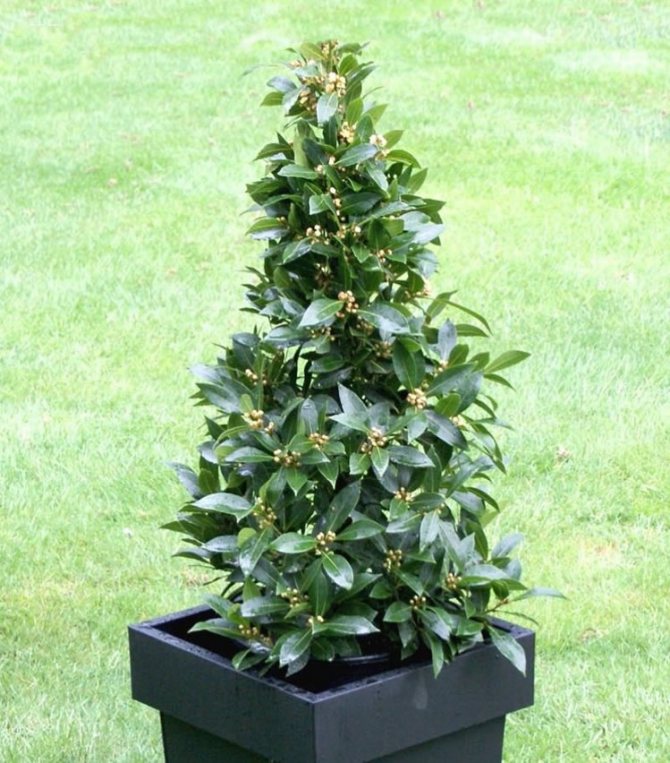

Before planting laurel in the ground, the seeds are kept in a solution of potassium permanganate for 3-5 days, as this accelerates germination. Upon completion of planting, the container with the plant must be placed in a warm place, moistened and covered with polyethylene. Before the sprouts appear, the polyethylene is removed from the pot for airing for at least 30 minutes a day. You also need to control the moisture content of the soil, it should be moderate, and liquid stagnation should not be allowed. In dry soil, the seeds die, and in a very humid environment, the plant rots.
Water the seeds and sprouts with settled warm water. The temperature of the liquid should be 4-5 ° C higher than room temperature. When the first shoots form, the cover from the pot must be removed, but the moisture content of the soil must continue to be controlled. When the first pair of leaves appears on the sprouts, the seedlings are transplanted into a spacious container, and humus and peat are added to the prepared soil (1: 1/2). After transplanting, the plant is placed in a dark place for 2-3 weeks, maintaining moisture. After 2-3 weeks, the seedlings are moved to light for active growth.
Diseases and their treatment
In natural conditions, laurel is a plant resistant to diseases. The presence of essential oils in the leaves scares pests. But laurel tree diseases appear when grown at home. Therefore, it is important to regularly prevent diseases and treat them in a timely manner.
If the bay leaves dry up, then spraying and watering should be done more often. When they turn pale, direct sunlight should be excluded. Top dressing is also added. If the bay leaves are sluggish, then this means that the temperature is high at the place of its location or there is stagnation of water in the pot. Common pests include:
- Shield. The leaves are damaged, brown-yellow dots remain. Affected trees must be isolated from others. The shield is removed with the help of Aktellik and Aktara. From folk methods, vodka and garlic juice are used, with which the leaves are processed. The bottom layer of the soil is changed.
- Mealybug. It is a pest with a length of 5 mm. A symptom of its appearance is the formation of white sticky mucus. The lesions are washed with a soap solution, and the bush is treated with an insecticide.
- Spider mite. This pest is difficult to spot. It can be detected by a white bloom, a cobweb formed between a branch and a leaf. As a preventive measure, regular spraying and moisturizing is required. If a weak defeat of laurel is detected, it must be washed with soapy water, and with a strong one, insecticides are needed.
- Sooty fungus. It affects the sheets, a rusty coating appears. This does not affect the development of the laurel, it only spoils the view. You can eliminate the sooty fungus by wiping the leaves with a mild insecticide solution and baking soda.
If any of these pests are affected, the laurel needs isolation from other plants. Only then should measures be taken to eliminate diseases and pests. Plant prophylaxis is also effective.
Outcomes
For successful cultivation of laurel in an apartment, you need to pay attention to the following fundamental points of care:
- The plant needs diffused lighting in summer, and brighter in winter.
- Maintain the recommended room temperature and humidity.
- Watering should be done in moderation, add spraying in summer.
- Pruning is done at will.
- Feeding with organics and minerals must be alternated.
- The topsoil should be loosened regularly.
- Transplant a young plant for the first three years annually.
- Take timely pest control measures.
Calendar of the main works on laurel cultivation
When growing and caring for laurel outdoors, you can focus on such a schedule for the main work.
| Season | Recommendations |
| Spring | In March and April, they carry out sanitary pruning of bushes and trees, removing damaged, lignified and frostbitten shoots. In cool greenhouses, cuttings are rooted. Plants are fed. |
| Summer | During the entire period, seeds sown in autumn germinate. With this breeding option, you must regularly feed the soil with nutrient supplements. In June and July, cuttings are planted. August is the time for crown-forming pruning of bushes and trees. |
| Fall | In October and November, ripe fruits are harvested, seeds are sown. At this time, leaves are collected from adult plants in order to prepare culinary or medicinal raw materials, damaged, diseased shoots are cut off. |
| Winter | During this period, it is necessary to observe a rest regime, moderate the frequency and abundance of watering, keep the plants in cool, bright, well-ventilated rooms. |
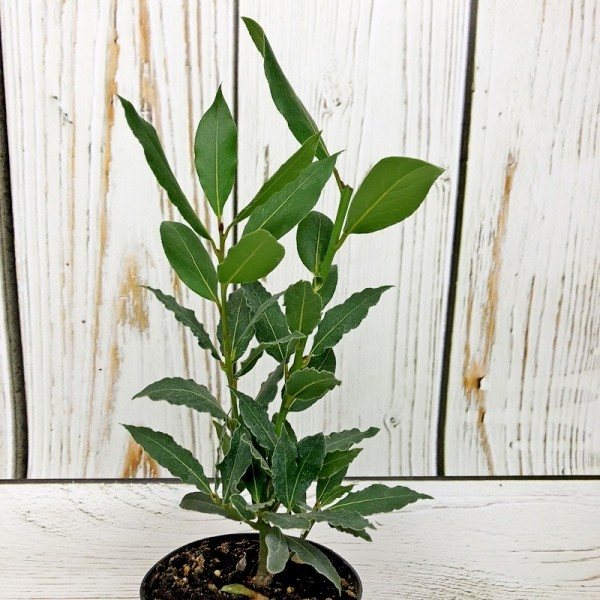

In autumn and winter, the plant is minimally disturbed, since it is dormant.
At home, such seasonal work is carried out.
| Season | Recommendations |
| Spring | Seeds are sown in March. In the first two months, propagation is carried out by vegetative methods of planting cuttings or layering. They feed the soil regularly. |
| Summer | During the entire period, seeds germinate, and regular feeding is carried out. Formative pruning is done at the end of summer. |
| Fall | October and November are the time for harvesting fruits, raw materials from the leaves. Top dressing is rarely done. |
| Winter | The first two months are at rest. Seeding can also be carried out in February. |


In spring and summer, the plant needs to be periodically fed, watered, pruned
Regular watering of plantings is carried out throughout the year. In the summer, plants are watered more often and more abundantly. In winter, the intensity and volume of irrigation should be reduced.
Comments (2)
Diana
14.07.2019 at 00:35 |
Outwardly, the plant looks like Benjamin Ficus. I tried to plant a laurel from a seed, but it did not germinate, apparently I need purchased seeds, I planted it from an ordinary bag with "Lavrushka", there I came across a seed among the leaves.Reply
Julia Expert Plodogorod
07/14/2019 at 16:38 |
Hello Diana! There are several reasons why a laurel seed might not germinate. For starters, this happens if stale planting material is used. It is difficult to predict how many seeds you have chosen are in the package.
Further, it is better to use some kind of developmental stimulant before planting to accelerate growth, or at least soak it in warm water. It is also better to remove the scales. It will slow down the emergence of the sprout, or even prevent it from emerging. If you do not carry out such a procedure, punching the sprout can take up to 5 months, and a florist who does not have this information may decide that there is no need to wait for the result.
But, even when creating optimal conditions for the emergence of seedlings, it takes about 4-5 weeks. You can use disinfected sand, not soil.After wetting it, a peeled seed is dipped into it and covered with a film to make a greenhouse.
If you just planted a seed in the ground, perhaps not loose enough, did not remove the peel first and did not soak it in water, then this is probably the reason it did not germinate. Although, perhaps the plant just took longer than expected.
If you decide to try again, then in addition to the option with sand, you can try a special soil for citrus or succulent plants. If you prepare the soil yourself, add more sand to it.
It is not very easy to buy fresh seeds, you need to look for a reliable trusted supplier. Therefore, we recommend looking for friends who already have such an exotic plant. Self-collected, fresh seeds germinate much more readily and faster.
But, if you get old planting material, you should not immediately throw it away. It just needs more time to germinate and you definitely need to use a growth stimulant, for example, Epin.
Reply
Signs
It is possible to grow bay leaves not only for use in cooking and air health. Also, many different signs are associated with it:
- A leaf in a plate indicates the fulfillment of desires.
- It is believed that a laurel branch placed above the door will not let a bad person and trouble in.
- The leaves in the wallet attract money if a special ceremony is performed.
- A laurel leaf fits in your pocket for a successful interview.
- If the leaf is caught in food, then this will lead to the receipt of money.
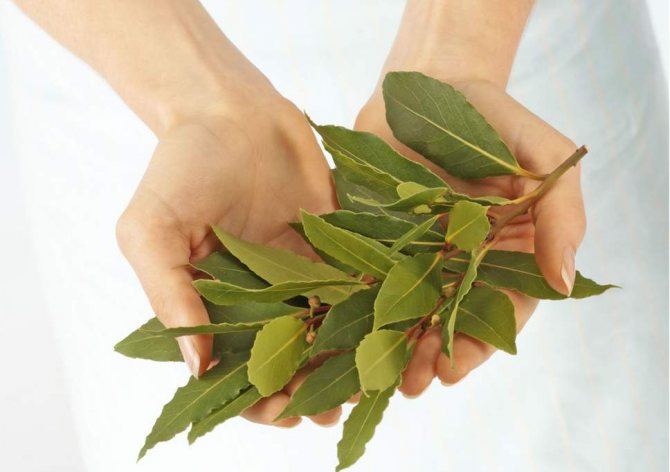

Even in gypsy magic, laurel leaves are used. They are placed around the house. With them, positive energy and well-being are attracted, negative is eliminated and evil is chased away. Here is such a beautiful tree you can grow at home. The main thing is to follow all the rules of care. Then the plant will look neat and healthy.
Features of care for cuttings
Rooted cuttings no longer require such close attention, but nevertheless, their care should be organized taking into account all basic needs.
Watering and spraying
Laurel does not like moisture too much, so watering the cuttings should be moderate. In the summer, the plant needs more liquid and additional spraying of the sheets (can be replaced by wiping with a damp sponge), while in winter the amount of watering is significantly reduced.
In any case, the top layer of the potted plant should always remain slightly damp.
Top dressing of a young plant
As a fertilizer for laurel cuttings, complex organic and mineral compounds are used, which are easy to find in specialized stores.
Some gardeners argue that mullein solution is also suitable for these purposes, but at the slightest violation of the dosage, the roots may simply burn out, so it is better to refuse this method in the initial stages.
Find the answer to the question "How to propagate laurel by cuttings?" - not difficult, but you should understand that this is a rather lengthy and painstaking process, so if you urgently need a full-fledged plant with a lush crown, then it makes sense to think about purchasing a whole bush at once. In the future, you can propagate it by the already mentioned method of cuttings.


Even a beginner can grow a bay leaf at home on a windowsill. The plant has long been adapted to indoor conditions and does not require increased care. Laurel noble is the official botanical name for a tree or shrub. Its leaves are distinguished by a spicy aroma, which is used in cooking.
The bay leaf was considered a sacred tree by the ancient Greeks. In addition, the plant has bactericidal and sedative properties, helps with insomnia. The chemical composition includes useful acids: formic, butyric, acetic, lauric. Biologically active substances relieve fatigue, increase immunity.
general description
Laurel can be called exactly that culture, which is quite easy to care for at home. Even a novice gardener can grow this plant.who does not have specific skills. In natural conditions, the laurel tree is very tall. You can find such specimens, the height of which is about 18 m.Currently, in the territory of Russia, in the Caucasian forests, you can see trees reaching 15 m.
Although it is not so difficult to grow a laurel tree at home, it is necessary to create a favorable environment for it. Indoor varieties of culture prefer to grow in lighted areas, but can adapt to the shade.
Bay trees are not afraid of drought, they are not affected by drafts. Growing laurel at home requires regular watering, while ensuring that the substrate is not waterlogged.
Indoor varieties are resistant to the development of various diseases and pests. To give the bushes a certain shape, they must be trimmed regularly.
There are many varieties of laurel trees. They are usually divided into two main groups:
- Noble ones.
- Canary.
Canary laurel is distinguished by the presence of large, wide leaves, the edges of which are slightly wrinkled. The main botanical cultivar is subdivided into three varieties:
- Golden.
- Narrow-leaved.
- Wrinkly.
Tangerine tree care at home
Between themselves, these varieties differ in the shape of the leaves and their shade.
Climatic conditions for laurel breeding
The noble laurel belongs to subtropical plants, which means that it is excellent for growing in those climatic zones where the temperature does not drop below -12 ... -9.5 ° C. In addition, in some cases, such plants can successfully tolerate short-term frosts and up to -15 ° C.
However, matching the climatic zone alone is not enough to guarantee the well-being of laurel in the midst of other trees in your garden. The success of cultivation is also influenced by other features of the territory, which, first of all, include the composition of the soil and illumination.
In nature, the laurel tree takes root well both in the sun and in partial shade, as well as in the undergrowth of deciduous forests. However, the full saturation of the leaves with essential oils is possible only with good sunlight throughout the entire spring-summer period.
Only in this case, by the end of November - the beginning of December, you will be able to get the most ripe seasoning for culinary purposes or excellent raw materials for medicinal use.
The benefits and harms of laurel
In addition to its widespread use as a spice in cooking, bay leaf has medicinal properties, it is included in many recipes of traditional medicine.
Laurel contains many vitamins and minerals, valuable acids and compounds, essential oils and tannins, camphor, phytosterol and linalool.
Thanks to such a strong composition, bay leaf miraculously affects health:
- Reduces blood sugar levels.
- Has antimicrobial and healing effects.
- Helps to lose weight.
- Boosts immunity.
- Relieves pain in gout and rheumatism.
- Helps to cope with insomnia and neuroses.
- Promotes the elimination of excess salts, toxins and toxins.
- It has a positive effect on the condition of hair and skin.
But there are contraindications to the use of bay leaves - this is the period of pregnancy and lactation, stomach ulcers, a tendency to constipation, hypertension, severe forms of diabetes and liver and kidney diseases, allergies.
In addition to all of the above, the smell of bay leaves scares off mosquitoes, midges and cockroaches.
Since ancient times, magical properties have been attributed to the bay leaf, they say that the laurel brings good luck, material wealth, health, and contributes to the fulfillment of desires.
Conditions of detention
A bay bush needs good diffused lighting. The best place for him is the window sills of windows facing east and west. In the summer heat, it is recommended to expose the container with laurel to the open air, where there is shading. In summer, the burning rays of the sun on the plant must be avoided. But in winter, when daylight hours are reduced, it is better to rearrange the laurel on the sill of the southern direction.
The soil for laurel requires light and permeable. It can be purchased at the store, a substrate for a palm tree or cactus is quite suitable. You can make the mixture yourself by mixing garden soil, humus and sand in a ratio of 3: 2: 1. The pot material is not important for this plant. The main thing is that it is not cramped and not too spacious.
The temperature of the laurel is required in summer + 20- + 27 degrees, in winter - + 12- + 15 degrees. At the same time, a decrease in temperature lower than +5 degrees is unacceptable, the plant may die.
Humidity should be kept within 50-60%. In the summer, spraying is used for this, or they put the pot in a pan with expanded clay, and pour water into the pan.
Ways and features of growing at home
In the wilderness and parks, laurel usually forms like a tree, and can reach a height of 25-30 meters in a lifetime. In indoor conditions, laurel usually grows up to 1.5-2 meters, although in the greenhouse of the botanical garden the plant has reached a height of 15 meters.
This slow-growing evergreen requires taking care of a large container, the roots of the plant require a large amount of soil, growth in small pots slows down significantly, and the plants look like toys. The presence of a large volumetric container is one of the important problems of how to grow a bay leaf at home on a windowsill. However, first things first.
Seat selection
In the wild, the tree prefers stony, well-drained soil in an open, well-ventilated area. When planting at home, this factor should also be taken into account - the place must be illuminated from all sides, and the room itself must have not only natural ventilation, but also the ability to ventilate.
For growing on a windowsill, it is recommended to place the pot on the south, south-east and south-west sides of the apartment.
The soil
You can grow homemade laurel using soil and soil available anywhere. For the preparation of a sandy composition, a forest sod land with the addition of humus and river sand is suitable. The humus should be 2 years old, rotted. Laurel noble in the first year does not require special feeding, it has enough nutrients that are in the soil. A mixture of soil is prepared from 2 mass parts of the earth, and one part of humus and river sand. If grown from seeds or stalks, it is enough to have a small pot for the first year. In subsequent years, the bay leaf must be transplanted into a container twice as large and at the same time increase the volume of humus by 1.5-2 times. When planting in a new container, you need to take care of drainage by putting expanded clay on the bottom.
Breeding options and preparation for planting
For a home nursery for growing laurel, you can use standard peat containers for seedlings, however, if you propagate the laurel with seeds.
By itself, laurel noble in the matter of reproduction is unpretentious. It reproduces well:
- Seeds (today, seeds can be ordered from online stores);
- Petioles;
- Layers.


You can grow bay leaves using seeds.
You can also grow a normal tree from seeds collected from wild plants. For this, the seeds are slightly dried after collection and stored in a bag at a temperature of 10-12 degrees. It is important not to overdry the seeds so that they remain viable. A small amount of mold on the seeds is not a reason to abandon planting, this is a completely normal process for laurel.Before planting, the seeds are soaked in a rooting solution, after which the shell is carefully removed and placed in a container. The depth of burial of seeds is 1.5-2 cm. During germination, the seeds should receive oxygen, so they should not be buried deeper.
To get friendly shoots, the container with seeds must be placed on the windowsill in February-March. Germination temperature is about 20 degrees. True, here you need to be patient, seedlings germinate unevenly, the first ones may appear in April, others may appear in August or even September.
When propagating by petioles, ripe one or two-year shoots are selected. For the preparation of petioles, twigs with young bark are taken. The best option is a petiole with three internodes. The stalk is cut at an angle. The bottom sheet is removed completely, the top two are cut in half.
For planting, a composition of sand and turf soil is being prepared. There must be drainage in the container. On top of the drainage, earth with sand is poured out with a layer thickness of about 4-5 cm.The sand is poured out in the second layer, 2-3 cm is enough.After that, a cutting is inserted into the container, the planting depth is 1.5-2.5 cm.
Rooting is carried out at room temperature + 18-20 degrees. To ensure normal rooting conditions, the container is placed in a plastic bag or placed under a jar. The appearance of a normal root system in the cuttings ends by 40-45 days after planting in the ground. According to many gardeners, the survival rate of cuttings is high, but getting a bush with beautiful shapes is more realistic from laurel seed.
Reproduction of laurel by cuttings: preparation of planting material
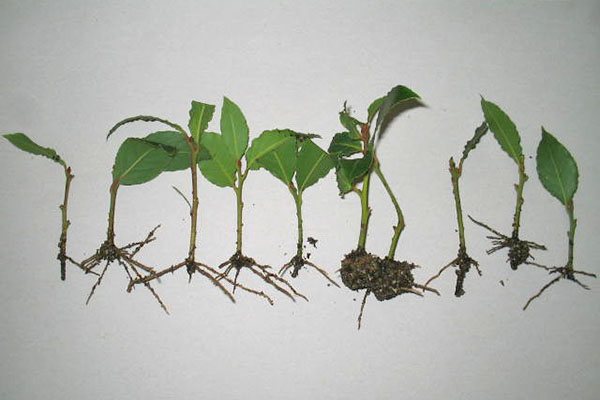

Compared to lemon, growing a bay tree in your home or office is easy. The plant wonderfully takes root even on the northern side, where there is not so much light. Interestingly, after 2 years, the plant will already have full-fledged leaves that can be used as a spice.
Reproduction of laurel by cuttings begins with the preparation of planting material. It can be purchased from the store or taken from an adult plant. Usually, cuttings are harvested in the spring or in the first month of summer, when the tree has completely moved away from the winter state. It is best to use planting material from annual stems that are not lignified.


In order for laurel cuttings to be successful, young branches are cut into small pieces of about 8 cm. Each of them should have at least 3 internodes (free spaces between leaves). The lower part of the twig should be cut under the oblique line.
When harvesting cuttings, the branches must be cut off with a sharp knife, but do not reach the end of the branch. The rest is slightly torn off together with the bark to form a "heel".
The leaf plates that are closer to the cut must be removed. The upper ones are easy enough to cut, leaving half of the leaf on the branch. This procedure is done so that the plant does not lose a lot of moisture.
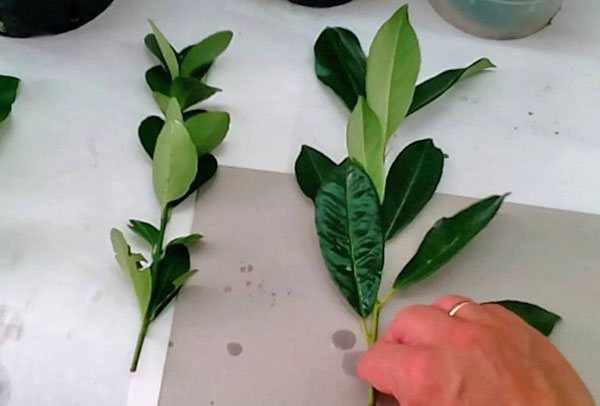

An easier way to propagate laurel by cuttings is to purchase planting material in the store. Usually they sell already rooted branches, which can be immediately planted in the ground. But it is advisable to carefully examine them in order to notice any damage or pests, for example, a scabbard. In addition, they must be elastic in nature, saturated with moisture.
How is the transplant done
- This operation does not need to be performed very often.
- A small tree should not be transplanted into a large pot.
- Laurel will do great in a small pot.
- When he grows up and the pot becomes cramped for him, another container is taken, with a large diameter of about 4 cm.
The transplant is performed by rearranging the earthen coma. The missing soil is poured into the pot. Then the transplanted laurel is watered well. Transfer work is usually carried out in the spring or summer.
Preparing for landing
When planted in open ground, the seeds are soaked in warm water for a day.To grow a bay leaf in the country, you need:
- dig up, loosen a sunny area with nutritious soil;
- make furrows 5 cm deep, water;
- spread the seeds at a distance of 5 cm from each other;
- sprinkle with earth.
When shoots appear, the plant is watered with warm water every other day. You can dive into pots or to a permanent place in the phase of 2-3 true leaves.
When growing at home, it is important to use non-acidic soil, fresh seeds (they lose germination after 3 months). Before sowing, they are soaked in a saturated burgundy solution of potassium permanganate for 24 hours in order to disinfect and treat pests.
When to plant seeds
To grow bay leaves as a potted crop, ripe seeds are planted in late February or early March. In this case, the air temperature must be at least 22 ° С. When planting in open ground, sowing is done in April.
Place and soil for planting
To grow laurel, you need to buy ready-made universal soil in the store or sow seeds in a special substrate. Its composition in liters:
- black soil - 3;
- sand - 1;
- peat - 1.
Before planting, the soil, both purchased and homemade, must be watered and baked in the oven for 2 hours.
Bay leaves prefer a sunny location without stagnant water. To grow it at home, an eastern or southern window sill and a pot with an opening for excess moisture are desirable.
We recommend watching a summer cottage program about planting a plant:
We produce laurel trees
There are several ways to get laurel planting material:
- cuttings;
- dividing the bush;
- air layering;
- seeds;
- vaccination.
Laurel cuttings
The most effective way is grafting. The material can be parts of the branches that are removed during the pruning process. Or fatty shoots (tops, or in English "suckers"), which are periodically formed at the base of the trunk. Semi-lignified shoots are cut obliquely so that each has 2-3 healthy buds. The lower leaves are removed, the upper leaf blades are cut in half.
- Rooted in wet sand, sphagnum or calcined soil.
- Perlite, vermiculite and other artificial substrates can be used.
- An acidic environment is undesirable - roots will appear, but they will develop sluggishly.
- It is recommended to pre-soak peat.
- A good idea is fertile soil under a layer of sand.
- The roots, having grown stronger in a safe environment, will penetrate into a more nutritious area.
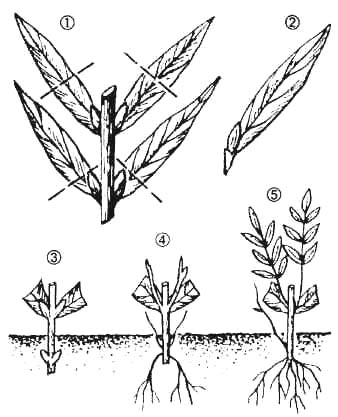

They are planted at an angle, after dusting the cut with a root stimulator. Without the use of heteroauxin, root or zircon, you will have to wait three to four months. The drugs will save a third of the time, or even half.
Keep cuttings warm and diffused light, protected from drafts and evenly moisturized. Best of all - covered with a mini-greenhouse. In six months, young plants are ready to take up personal flowerpots.
Division of the bush and layering
The division of the bush is carried out in the fall or early spring, when the plant is in the sleep phase. Divide fairly - so that each of the branches gets a part of the viable roots.
An interesting way is air layering. Several notches are made on a healthy shoot and, sprinkled with growth hormone, wrapped in sphagnum. Alternatively, a plastic bag with a substrate is fixed on the stem. Roots will appear in the area of the notches. When the substrate is penetrated with them, the cuttings are separated from the main stem.
Laurel from seeds
Home laurel may bloom, but it is unlikely to give seeds. He is a dioecious plant, and it is not a fact that there will be a specimen of the opposite sex nearby. Nevertheless, the seeds of the noble laurel (fresh, after two or three months they lose their germination) can be brought from a trip. They sprout, as they say, for an excruciatingly long time. Six months or more. However, patience will be rewarded. Laurel of seed origin is durable (fifty years of life versus twenty for those obtained vegetatively).In addition, having emerged from a seed in a room environment, it is maximally adapted to it.
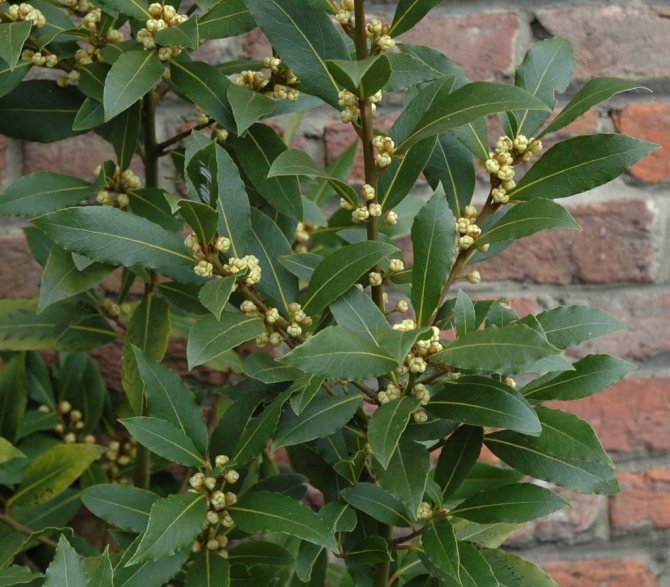

When is vaccination needed
Reproduction of laurel by grafting is used when replicating its decorative forms. There are not so many of them, but they are:
- Laurus nobilis f. Aurea - young leaves are painted in a delicate golden color;
- Angustifolia - with narrow, long leaves, reminiscent of willow or willow tea;
- Undulata - with corrugated leaf edges.
There is another type of laurel, Laurus azorica (Azores, or Canarian). Its leaves are somewhat smaller, and the shoots are pubescent. For the enthusiast, try grafting L. azorica on a less whimsical Mediterranean cousin.
Botanical description of laurel
The plant is dioecious, that is, female flowers and male flowers appear on different trees. Small inconspicuous flowers form an inflorescence - a brush. After flowering, small berries appear, black in color. They are shown in the photo below.


Leathery leaves contain essential oils that give off a pleasant scent. The plant is a frequent representative of the Mediterranean flora, lives in Krasnodar and the Crimea, where you can easily buy brooms from fresh branches on the market.


Dried leaves are used as a spice, and they are also widely used in folk medicine.
Laurel varieties for growing on a windowsill
In natural conditions, laurel trees reach 15 meters in height. An indoor plant can be either a full-fledged tree or a small bush. Consider the best subspecies for growing on a windowsill.
| Variety name | Characteristic |
| Canarian or Azorean | A widespread species, it is distinguished by dull green leaves in the shape of an egg. Their length is no more than 13 centimeters. Outwardly, it is similar to the classic laurel, but it is not used in cooking. Yellow flowers appear during the flowering period. The Canarian variety is used for decorative purposes. |
| Noble or ordinary | It is this species that is commonly used for food. Leaves are dark green, glossy, without spots. Evergreen shrub with a dense crown. |
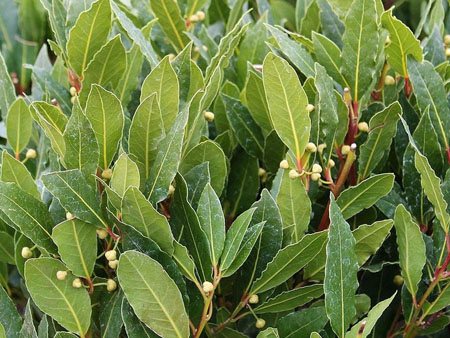

The noble variety is divided into 3 subspecies: wrinkled, golden and narrow-leaved laurel. Under favorable conditions, the life span of a plant is 15 years.
Signs of trouble
Leaves turn yellow, curl and fall off - insufficient air humidity. Regular spraying should be established.
The outer side of the leaves is covered with brown spots. - waterlogging of the soil, especially in combination with low air temperature and / or irrigation water. Watering needs to be optimized.
Why do laurel leaves turn black?
The leaves are covered with a spotted black bloom, which is easily erased from the surface of the leaf blade - a sooty fungus that settles where there are traces of the vital activity of pests: scale insects or mealybugs. First of all, they get rid of pests, then remove plaque. In case of severe damage, the affected leaves are removed.
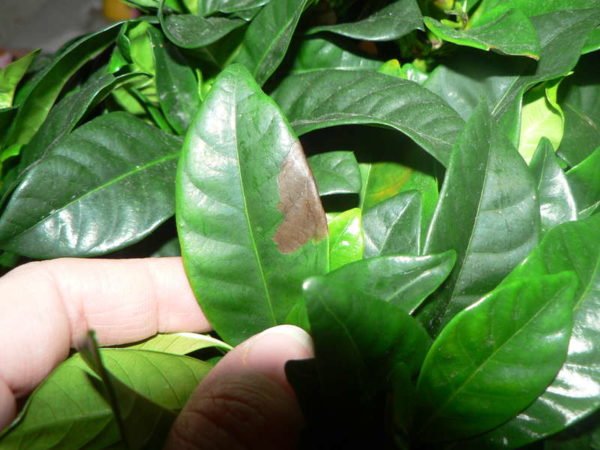

Rooting methods for cuttings


When the planting material is already in hand, it is important to start rooting it. There are two methods available on how best to do this: in soil and in water. First, let's look at how to root laurel cuttings on the substrate. To do this, first prepare a special soil. You can use any of these options:
- mix sod land with marsh moss in half;
- take one part of sand and the same amount of sod soil;
- mix sand with marsh moss;
- prepare coarse sand.
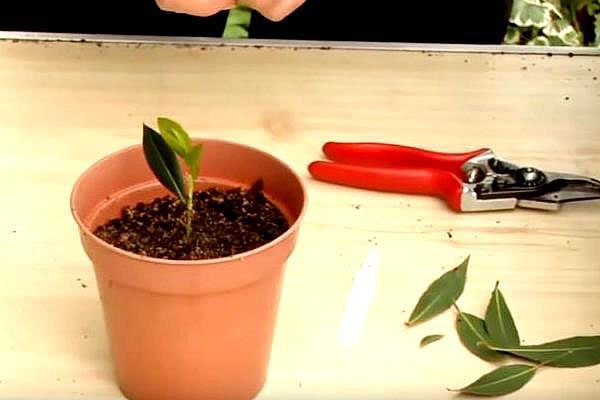

When the choice is made, it is advisable to disinfect the soil with hot water. The sand can be simply ignited over a fire. The procedure will protect the cuttings from harmful bacteria. Drainage made of broken brick, pebbles or expanded clay must be placed on the bottom of the container. Then, a shoot from a bay leaf is planted in the finished substrate. The plant is lowered into the ground by 1.5 cm, squeezed slightly, moistened a little, and then covered with polyethylene. At home, you need to carefully monitor it so that it takes root well.
In order to avoid contact of the cutting with the shelter, it is advisable to install small protective pegs.


For better rooting, the sprouts are treated with growth stimulants, after which the containers are placed in small greenhouses. The optimum room temperature should be approximately + 25 ° C. Young shoots are sprayed with water every day and ventilated by removing the plastic cover. Thanks to this care, after a month, the cuttings will have roots. Then they can be safely transplanted into a new pot.
But how to root cuttings in water to grow an exotic tree at home? Someone might think that this method is not particularly reliable for such a plant. In fact, it is enough to adhere to the basic operations for the plant to successfully root. And then it will be able to delight the owners with spicy leaves all year round.
All you need to do is take a small container, pour water into it about 5 cm in height and place the stalk there. Tara is taken to a dark place. Throughout the rooting period, the water is not changed, only as needed, periodically topped up.
Creation of the necessary conditions: temperature, lighting, air humidity


Laurel tree is unpretentious to temperature conditions. The plant prefers fresh air with a temperate climate. In the summer, it is useful to take out pots with bushes to a loggia or balcony. + 18-20 ° С in summer is a favorable temperature for the plant.
In winter, laurel can easily endure low temperatures. + 10-15 ° С are not terrible for the bush. On cold windowsills on the north side of the window, the plant does not experience discomfort.
Regular ventilation is essential to maintain a moderate indoor air humidity. The plant itself is sprayed from a spray bottle or irrigated in the shower.
In winter, the bay bush is kept in partial shade, since the plant slows down growth.
When it comes to lighting, there are no hard and fast rules. In order for the laurel tree to bloom and be lush, it is better to choose well-lit areas of the apartment. The windowsill is a great place to grow laurel. The bush does not need additional lighting.
Place and light
A noble laurel needs an illuminated area with diffused light. Since this plant is shade-tolerant, it is also kept in a shaded place. However, growing it under diffused light conditions leads to flowering, and the bush itself becomes much thicker.
In the heat, do not allow constant direct rays of the sun to hit. In the summertime, the plant is taken out into the garden or on the balcony. In an apartment, pots are placed on the floor near the windows, in the corridor or hallway. The plant needs regular ventilation, but constant drafts should not be created.
Propagation by cuttings
Already rooted cuttings can be found in flower shops and markets. But it takes a little effort to root a small cut stick yourself.
Preparing cuttings
The best time for plant propagation by cuttings is considered a warm period from early April to late June. Some growers prefer to harvest cuttings in the fall.
For the reproduction of laurel, the lower and middle branches of a plant with a stiff bark are suitable. They are separated from the main trunk by an oblique cut. Long branches are divided into 6-8cm pieces. There must be at least four live buds on the handle.
The lower leaves are removed from each cutting, and the upper few are shortened by half.
Rooting in the substrate
For rooting cuttings, a sandy substrate or a mixture of sand and peat is used. The ready-made soil mixture is placed in the container in layers:
- drainage - at least 1/3 of the volume of the pot;
- peat or turf soil to about half of the remaining volume;
- sand is poured into the pot to the top.
Prepared cuttings of laurel are planted in well-moistened soil, deepening them by 1-1.5 cm. If the capacity is large, and there is a lot of planting material, use a 10 * 10cm planting scheme.The soil around the cutting should be slightly compacted with your fingers.
A small wig is made of cellophane film, plastic bag or glass around the container. In order to prevent the cutting from contacting with condensation formed on the film, it is necessary to make small props.
To speed up the growth of roots, you can resort to some simple tricks:
- before planting, treat the cuttings with growth stimulants;
- during rooting, maintain a temperature of + 25C;
- ventilate the greenhouses daily by removing the shelter;
- do not forget to regularly spray the planting.
Rooting in water
To root laurel in water, no special training and skills are required; it is enough to lower the cuttings into a container of water no deeper than 5 cm. The container is placed in a warm, dark place for several weeks.
The water under the handle cannot be changed, but if necessary, you can top up to the required amount of fresh water. For successful rooting, you can use a ready-made aquarium composition. It contains all the substances necessary for life.
In order for the root system of the cutting to begin to develop faster, before being placed in water, it must be immersed 2-3 cm in a growth stimulator. Carry out processing for no more than an hour.
Pruning and shaping the crown
Usually, the pruning of branches and the formation of the crown of the plant is carried out in March, if by this time the young shoots have managed to grow up. Some gardeners recommend doing this in August so that new branches will grow the next spring.
To improve the development of laurel, the old lignified branches are cut off by about 20 cm. A sufficient number of buds should remain below the cut so that the shoots that have grown from them subsequently form a voluminous crown.


Once a year, in March or August, it is worth pruning the plant - this will ensure the active growth of the crown
With the help of trimming, laurel crowns can be given a wide variety of decorative shapes - a ball, a cone, a pyramid. This procedure should be started from an early age of the seedlings.
Important! To give the desired shape, you need to prune the branches a little, but often.
Origin
Laurel noble originated from the genus of evergreen plants of the Laurel family. Since ancient times, lavrushka has been grown in most of the subtropical countries. Even then, it was known what benefits the seeds, leaves and fruits of laurel brought.
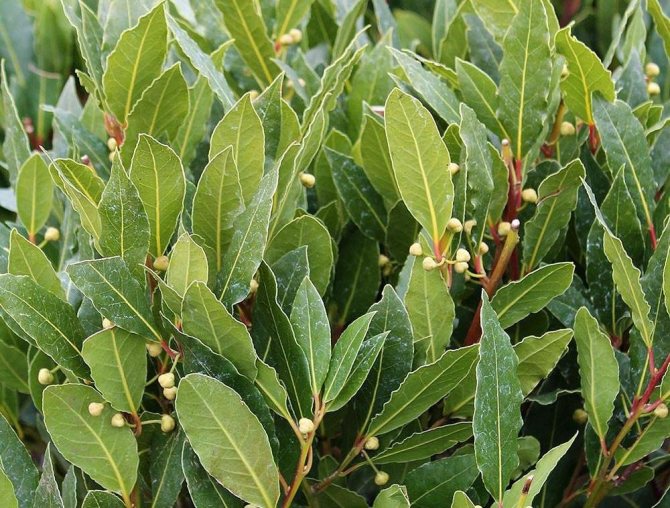

Bay leaf, shrub
Important! The leaves and fruits are used in pharmacology. After the processing process, concentrated infusions and oils are obtained, which work as a powerful diuretic. The plant helps not only in matters of flatulence and intestinal colic. It is considered one of the newer, younger tools for treating lingering depression.
The plant was brought from the Mediterranean. There are cases when the laurel lived for about a hundred years and had a height of ten meters.
Cooking applications
Dry and fresh leaves, fruits, powder made from dried leaves are used as a spice. They also use briquettes into which the crushed plant is pressed. The sheets are used in canning. They are used to refine and flavor sour dishes - sauces, gravies.
Leaves are added to the first courses - soups, cabbage soup, borscht. They make the second courses of lamb, beef, pork, boiled and stewed fish spicy. They are combined with vegetable side dishes: beans, peas, beans, cabbage, carrots.
The bay leaf is added 5-7 minutes before the dish is finished cooking. It is enough to put from 1 to 4 leaves. When the spice is added, the lid must be closed. The spice is removed from the prepared dish before serving.
The sheet allows you to correct the taste and smell of jelly and offal dishes. It is used in the food industry to create cheeses, sausages, pates, stews, sauces, marinades, for canning fish, making mayonnaise and ketchup. At home, the leaf is also used in canning. With other spices, it gives a pleasant taste and aroma.
Types of laurel
There are three types of laurel tree:
Camphor, Whose homeland is China. The plant is quite popular in Asia and India. It is an evergreen plant with tough, lanceolate, fleshy, speckled leaves.
Flowering lasts about one and a half weeks, with yellowish inflorescences.
Laurel tree contains a lot of camphor oil, most of it is in the trunk and wood of laurel about 90%. The production of camphor is widespread in Japan and China, where oil is obtained from laurel shavings and branches by distillation.
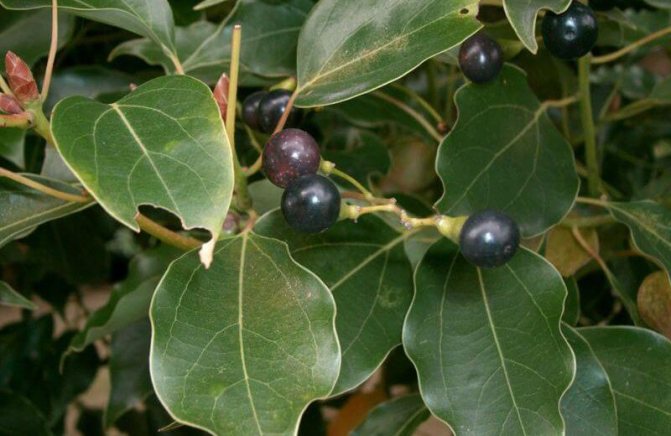

In addition to camphor oil, laurel leaves contain a large amount of selenium and tannins. Camphor oil is considered one of the best medicinal substances in the fight against heart disease, depression, for the prevention of infectious diseases.
Outwardly, camphor oil is used for rubbing sore joints and bruises, as an analgesic, distracting and anti-inflammatory agent.
Noble laurel. The most common type of laurel tree, it grows in the southern part of the country and in the Mediterranean. Laurel trees reach up to 5 meters in height. The branches are glabrous and fleshy.
The foliage is lanceolate, on a short petiole, with a glossy surface, oblong in shape. Laurel bloom occurs in spring and lasts about a week. Inflorescences with small flowers, collected in yellow umbrellas.
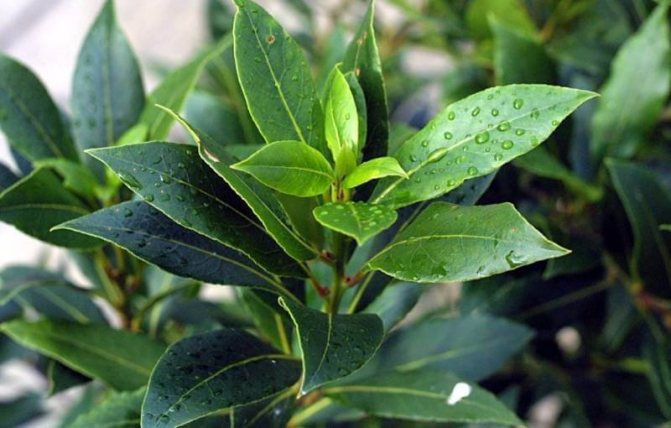

The noble laurel is used to compose decorative compositions and decorate interiors. The noble species is unpretentious and resistant to drought, grows well in pots in indoor conditions. The foliage is used to produce essential oils and as a spice.
The winners in Ancient Greece were awarded with a branch of noble laurel, the plant was attributed to divine origin.
Azores laurel or Canary laurel tree. The Azores islands are considered the birthplace of the plant. The trees grow up to 12 meters in height with large leaves, dark green in color, 5.5 cm wide.
Blooms in spring. Pale yellow inflorescences are collected in umbrellas and are located in the axils of the foliage. Azores laurel is often used for decoration.
The most common varieties of laurel trees are narrow-leaved and willow laurel.
Lifeless patrician
Contrary to its noble status, the laurel is not distinguished by excessive claims to the conditions of life. Compared to, for example, citrus fruits, caring for it is quite simple.
Laurel is a plastic plant. The woody form, as it moves up the mountains, turns into a squat shrub and instead of rich soils it is content with rocky soil. But since the room conditions themselves are an uncharacteristic environment for a tree that loves space, it would not be a bad idea to bring all the other parameters closer to the comfort zone.
Light for the tree of peace
In natural conditions, laurels are open to all winds and receive a full dose of insolation. Home laurel will willingly settle near the south window and will not mind direct rays. The western and eastern expositions are also acceptable, except that the branching of the tree will become somewhat weaker.
Is the laurel shade-tolerant? Many sources say yes. And in a sense, this is how it is:
- Young laurel is shade-tolerant than an adult.
- When the plant is dormant, it can be placed near the northern windows.
The laurel can spend the entire warm period in the open air. When moving a seedling to a brighter light, you should take care of a light screen, otherwise the leaves and even the bark will get burned.
You should not turn the pot of laurel, trying to ensure that all parts of the crown receive their dose of light: the trees are oriented relative to the magnetic poles of the planet and the displacement is perceived as stress.
Temperature regime
A seasonal schedule is more natural and preferable than keeping in an even room environment. Daily fluctuations are also welcome. In general, the temperature regime is as follows:
- winter - from 7 to 10 degrees Celsius;
- spring-summer - 17 ° C at night and 25 ° C or slightly higher during the day (i.e. the usual range of the middle band).
If possible, in the spring, the laurel is placed on the terrace, balcony, or taken out into the garden. They return it under the roof when night temperatures drop below plus three.
Even the subtropics are rare, but they are harsh. Especially in the mountains. Laurels easily tolerate small, up to minus five degrees, freezing temperatures for quite a long time. In regions with a mild climate, they spend the winter in unheated greenhouses. They can withstand short-term drops to minus ten and below. The main thing is that the wind does not join the cold, bringing dehydration and death: dormant roots do not drive moisture up, but the leaves continue to evaporate, at least a little.
Planting a laurel tree using a cutting


After the sprout has released enough roots, they begin to plant the plant. For this, choose a suitable container and soil. The pot should be small at first with a hole in the bottom where the drainage layer will be placed. Then they put a layer of turf soil, and sand on top. The ideal option for planting bay leaves with a cuttings is to purchase a carbonate mixture at the store.
The process of how to plant a bay leaf in a prepared substrate consists of the following simple operations:
- the pot with the cuttings is well moistened so that it easily comes out of the soil;
- carefully remove the sprout and transfer it to a new place;
- a small funnel is made in the soil, 2 cm deep;
- a stalk is placed in it;
- fall asleep with sand;
- slightly moisturize.
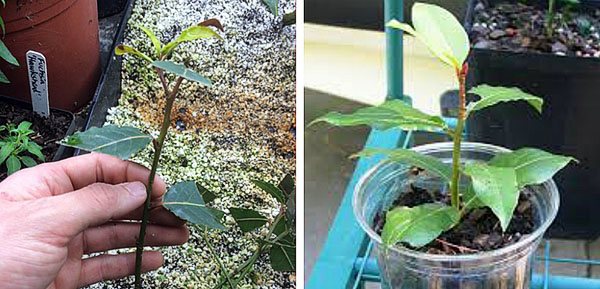

To protect the plant from fungal infection, do not overfill it with water. It is better to do this in small portions as the top layer of the earth dries up. In addition, laurel will not refuse regular feeding. In specialized stores, they sell various types of organic mixtures or mineral fertilizers. Some gardeners use a weak mullein solution. In this case, you should be especially careful when preparing the substance, carefully observe the dosage.
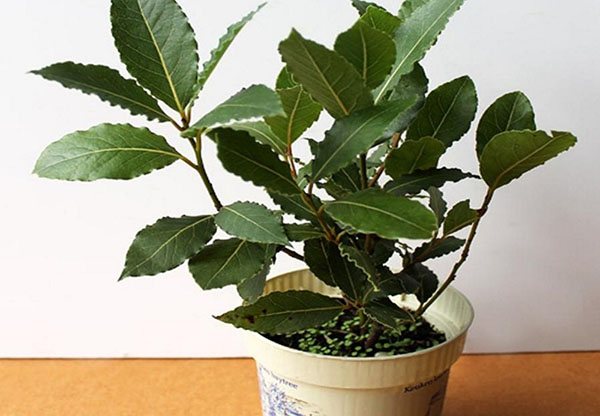

Otherwise, the roots may simply burn out and the plant will die.
The plant must be transplanted into a new container every year. When he turns 5 years old, the procedure is done once every 4 years.
By placing several pots of laurel on the balcony, you will not only decorate the room, but also saturate the air with unusual freshness.
We grow laurel in the kitchen - video
Growing plants by cuttings is the most popular way of their vegetative propagation and laurel in this regard is no exception. Growing a laurel from a cutting is not so difficult, especially when you consider the following nuances.

